
What Does the Online Travel Booking Process Look Like?
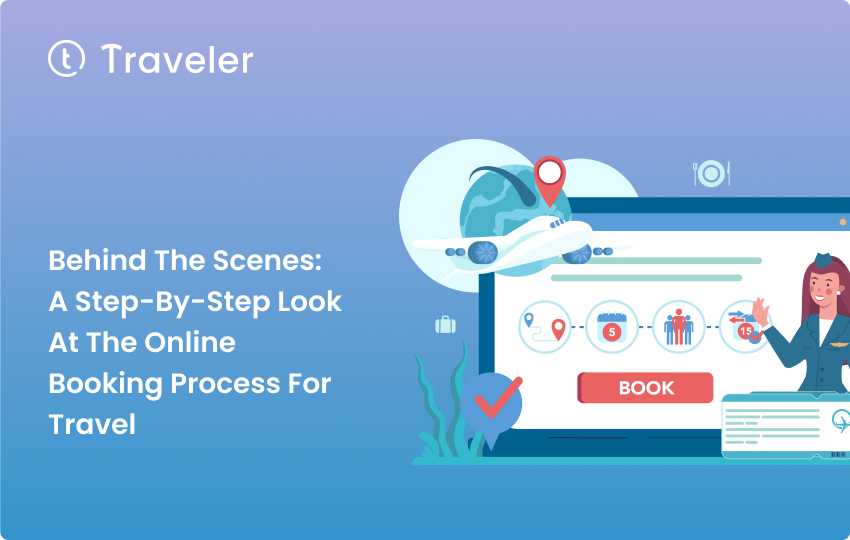
Table of Contents
Customers are getting more and more options when it comes to travel, which is making the hotel business very competitive on digital platforms. It’s easy to lose out if your website and booking engine don’t match. Let’s explore some ways to optimize your online travel booking process and make sure your customers have a smooth and seamless experience.
In a world that is becoming more digital, it shouldn’t be a surprise that a big part of the hotel room business is done online. People often go to the websites of travel agencies to get information ahead of time and to make reservations.
There are many benefits to booking online. The main reason for a hotel to have its own online hotel booking engine is so that it can get reservations without having to pay commissions to a third party. Online travel agency (OTA) means that the hotel will make more money directly.
A secure, self-service platform that lets your guests book through your website at any time and from anywhere, without help from staff. This makes sure you never lose a booking because you don’t have enough staff. For international travelers, that means they don’t have to worry about time zones when making reservations. Also, online booking tools make the booking process more professional and say a lot about your brand and services.
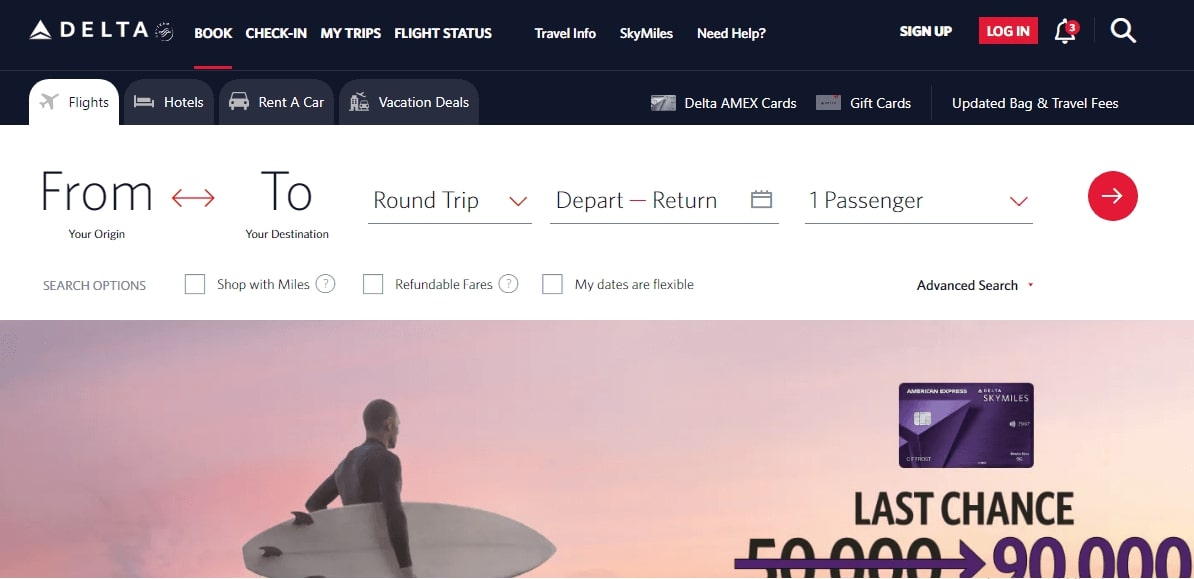
The Online Booking Process
The main goal of an online booking system is to let people book and pay for themselves on your website. All of the back-end management features are just a huge bonus.
So, you might be interested to know how the online booking process looks to guests. Because if they can easily follow the steps, you’ll be able to get more direct bookings and make twice as much (or more) money.
As technology improves and gets more modern, most hotels now let people book rooms online. But it can be hard or confusing for people who have never booked a hotel online before to do this. But the steps below will help people who have never booked a hotel online understand how it works and book a room quickly and correctly.
Choosing a travel service
When you go to the websites of the big travel agencies, you can see on the top bar that they offer different services, like planes, hotels, car rentals, packages that include both planes and hotels (like a tour) to help customers save time on travel, and other services. First, you should decide what kind of service you want. For example, you might want to book a flight or find a hotel for your trip.
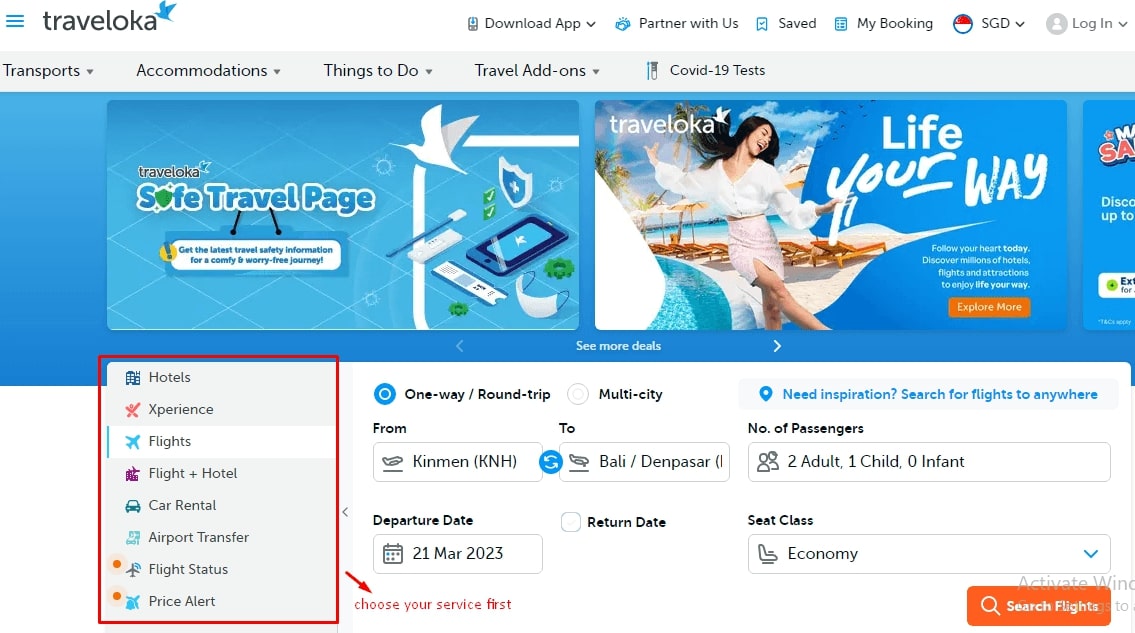
Selecting travel dates and destinations
After you choose a service like a flight or hotel that works for you, you can see in the middle of the screen that you have a lot of options. You should think carefully about when you will arrive and when you will leave. Don’t forget to set a firm and good date for your trip.
You should also think about what the weather is like there and what big events or festivals are going on to help you find more interesting things to do on your trip. One more thing to keep in mind about choosing a fixed time: if you book a hotel room, you must check out on the same day so you don’t mess up the plans of the next person who booked a room at the same hotel as you.
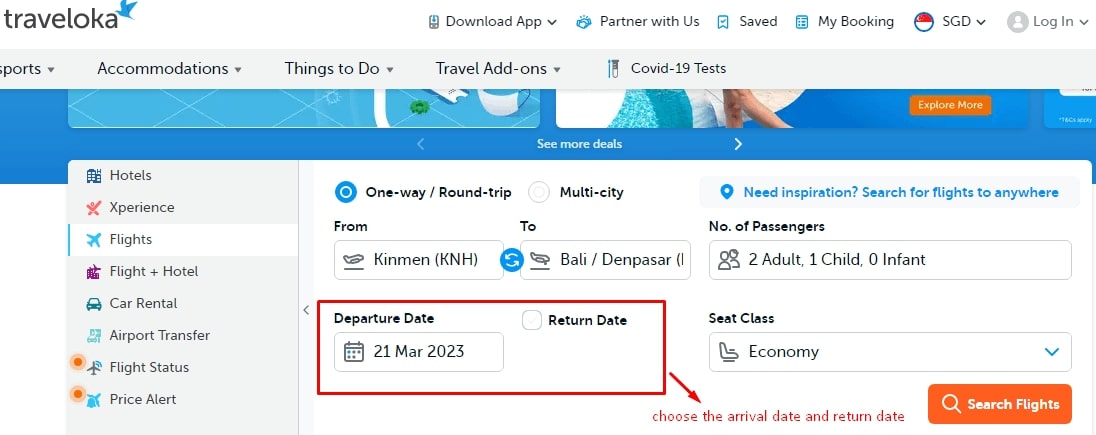
Choosing specific travel options
You should find the right room type for your trip based on how many people will be going. Because there are so many options for how many people are going, the reservation system can suggest suitable room types without any trouble or worry.
The website will show you everything you need to know to book a hotel room, including the address, a picture, an introduction, a list of room prices, the amenities, and the rules of the hotel. Which hotel do you like? You can choose your arrival date, your departure date, your room number, the number of adults, and the number of children. After that, click Done or Find.
Choose the right room rate, look at photos and the room’s features, and think about adding an extra bed. Click Book Now to keep going.
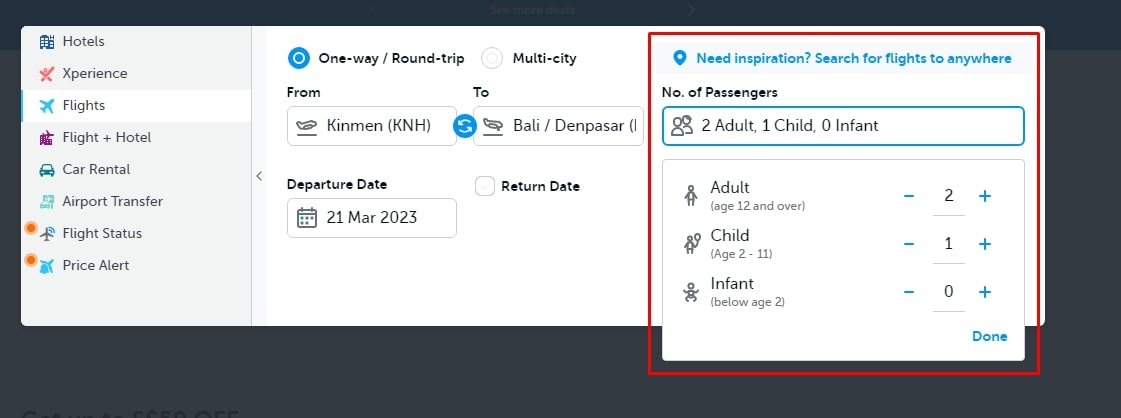
Entering passenger information
After you choose the hotel where you want to stay and decide whether you want to book through a travel agency or directly on the hotel’s website, you can book a hotel online. After that, you’ll click “booking” and fill in some basic information about yourself, like your first and last name, phone number, email address, the room number you want to book, the type of room you want to book, how many people will be staying there, etc.
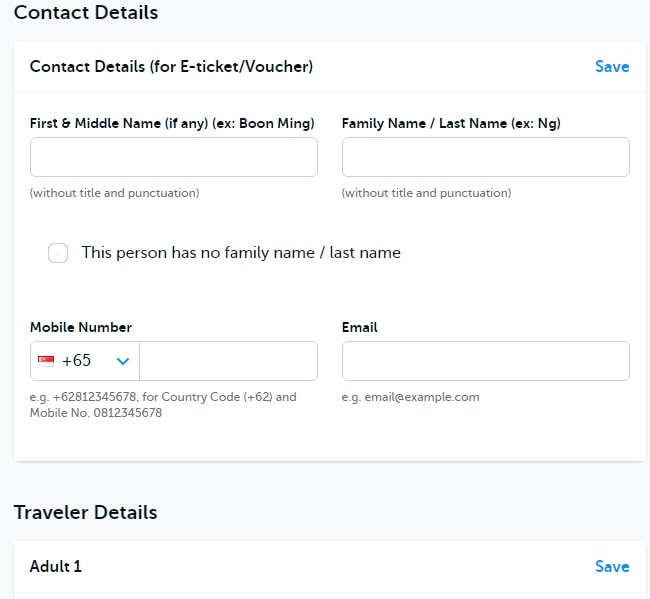
Making a payment
With the growth of the internet, travel agents now offer more ways to pay for hotels that are booked online. You can pay with a bank card through online banking, a credit card, an e-wallet, or at a cash collection point, among other options. With different ways for customers to pay, goods are also easier to buy.
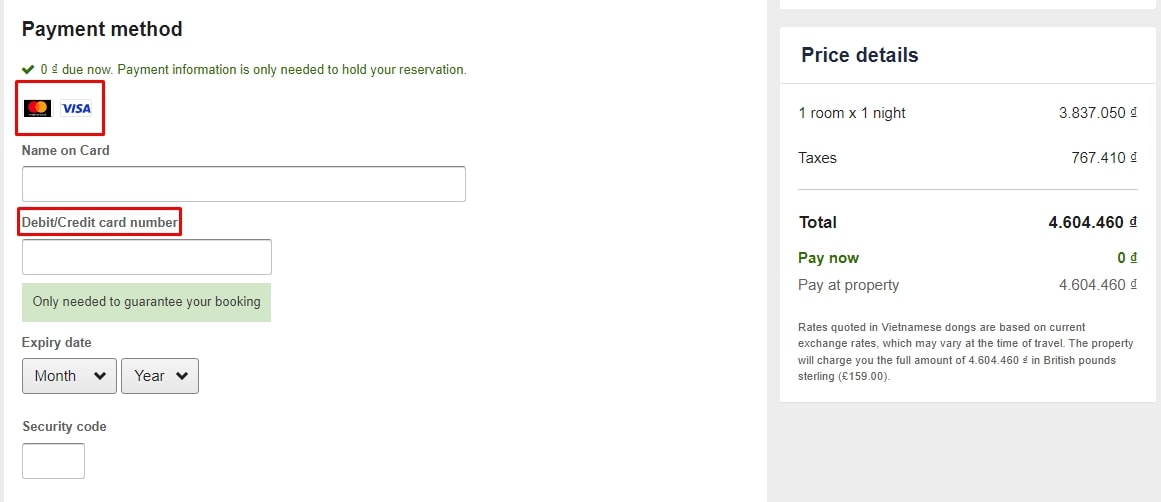
When you book online, you may get a discount if you pay with a certain e-wallet or a credit card from a certain bank. So, you should check to see if there’s a way to pay that helps you save the most money.
If you are going on a long trip and need to stay at a hotel for several days, you can pay for the room for the first two or three days before you get there. The rest of the stay will be paid for when you get there. But not all travel agents or hotels let you do this, so before you pay, you can call and ask.
Reviewing and confirming booking details
After you pay for your online hotel reservation, the system will send you a confirmation email. A booking confirmation receipt and a booking code are often sent to the booker’s email or phone number these days. When you check into the hotel, this reservation code is one of the most important pieces of information you’ll need.
P/s: If you’re looking to take your hotel’s online booking process to the next level, you might want to consider using the WordPress travel booking engine payments gateway add-on . This powerful tool enables you to seamlessly integrate payment gateways into your booking engine, making it easier and more convenient for your customers to pay for their reservations online. In this introduction, we’ll explore the benefits of using this add-on , as well as some tips for getting started.
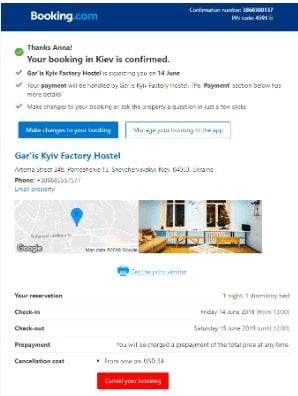
Carefully check the confirmation receipt
Lastly, it’s your job to double check the confirmation receipt to make sure all the information is correct. This includes the check-in date, check-out date, agreed room rate, number of rooms, booking information,… When everything is right and your online hotel booking is done, all you have to do is wait for the day, pack your bags, and go!
Real example of an online booking process
John and his wife, Mayar, stop in London for two days before going on vacation to Mozambique. John convinces Mayar that taking a bus tour is the best way to see more of the city since they don’t have much time.
Choosing a flight on Delta Air Lines' website
The best time for their trip will depend on what they want to do and what they need. John can go to the website and type in the basic information about the trip, such as the date of departure, the date of return, and the number of people who will be going. This will show him which flights are available on that day.
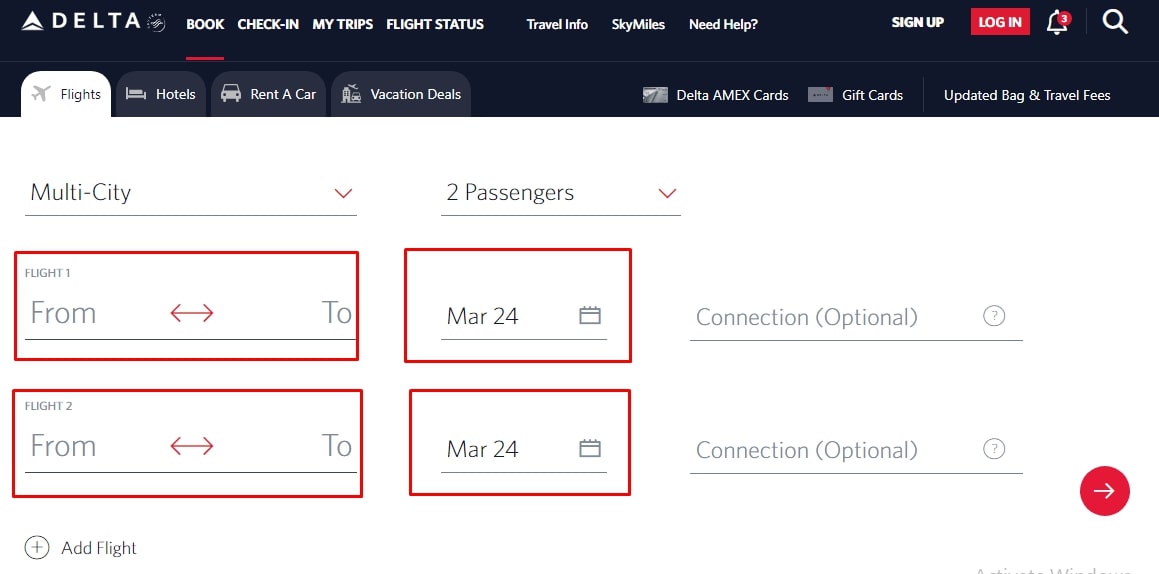
Searching some available information
Before booking a room on the website, John can find out some information, review the comments of bloggers or other customers on the website to check the brand’s reputation. By searching for keywords on google like “best bus tour in London”, or “impressive places to visit in London”, .. will have a lot of articles appearing with the website that they trusted booking to make their trip before.
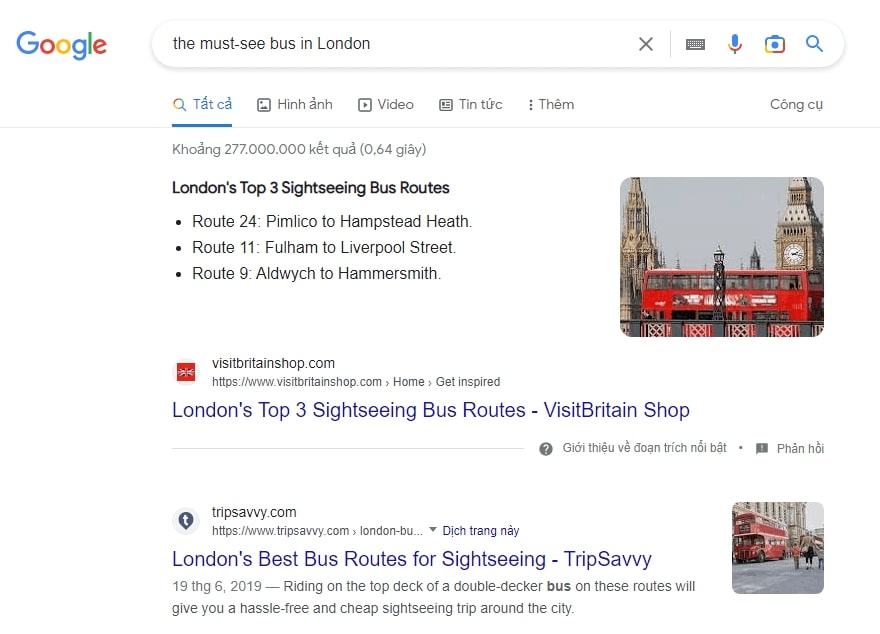
Begin booking and Make a Reservation
John returns to their website, selects the bus trip, clicks “Book Now,” and then follows the on-screen instructions.
- Fill some information about your time travel including your arrival date, return date and the number of people joining your journey
- Compare the price and information of each service, for example, compare the prices of hotel A and hotel B, find out about the location, about the service and other amenities.
- Make a reservation and fill in some payment method information
- Reviewing and confirming booking details. It can be sent via email or SMS
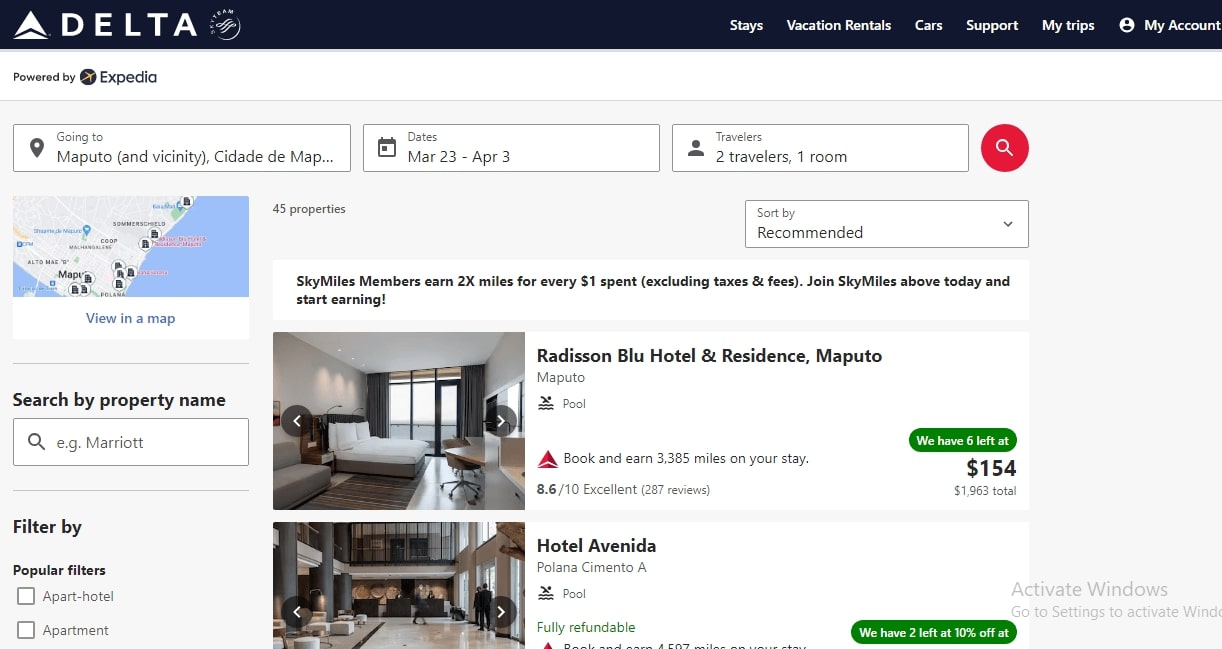
Advantages and Disadvantages of Online Booking
Reservations can be made at any time on travel website
With online scheduling platforms, your company is accessible every day of the week, 24 hours a day.
To reserve a golf time, go anywhere. In other words, your clients can book a table whenever it works for them. Consumers spent more than $450 billion online in 2017, and this figure is only going to rise. Furthermore, research has shown that having something available right away when browsing for goods or services significantly boosts the number of purchases or appointments.
You can attract more customers who want to make an appointment or a tee time online.
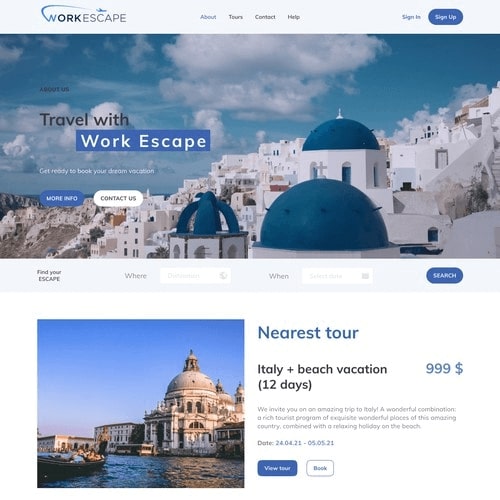
Convenience and ease of use
By accessing a reputable travel website, you can search for any information and can rely on the 24/7 support or a virtual assistant. A room may be reserved at any moment. All your wishes and plans are available in the search engines without spending too much time traveling to a live travel agent to book or pay for services.
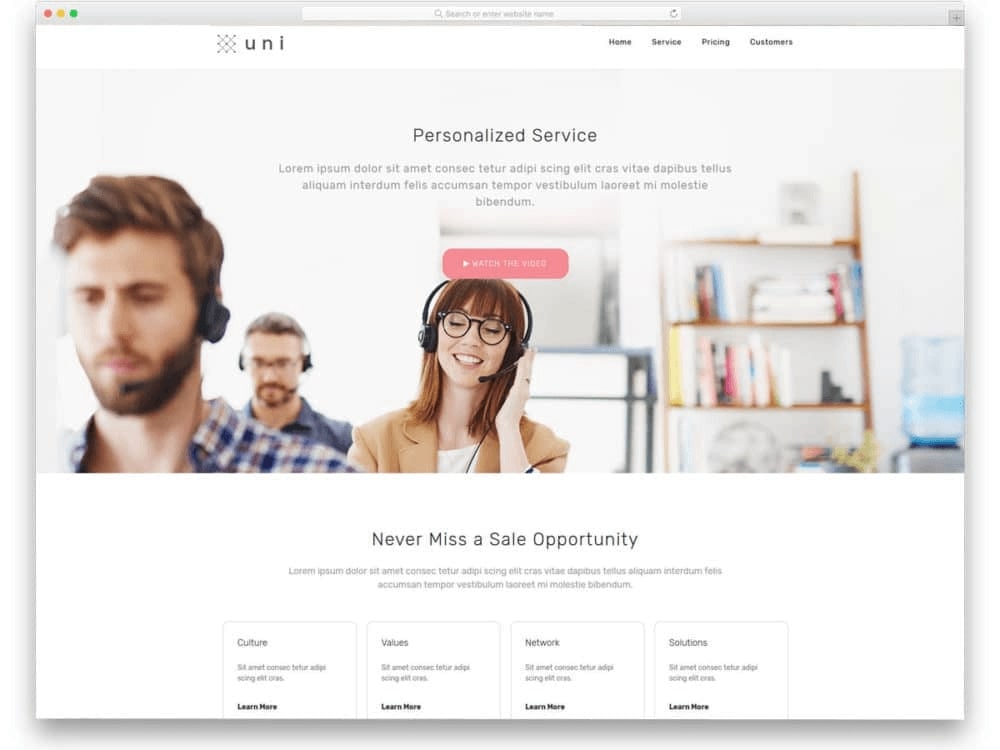
Ability to compare prices and reviews
When you book a room online, you’ll find there are plenty of choices. Before booking, you need to research and find reputable websites, have many people to choose from and feel satisfied after your trip because of good service. You can also freely compare the prices of other travel agents to find the services that suit your needs.
Disadvantages
Potential for technical issues and errors
If you book during the tourist season, there will be more bookings, so there may be some errors such as a slow website or problems that need to be refilled. For each situation, there will be different solutions and remedies. It is important that you better book at times when other people are resting.

The wrong booking system could make your job more difficult.
The proper online booking platform will make it simpler to accept, handle, and expand your bookings, whereas the incorrect one may make it more challenging to do so. If visitors find it difficult to make reservations, a poorly designed reservation system may even have the unfavorable effect of degrading customer service. Therefore, it’s crucial to take your time and thoroughly select your provider.
It is now simpler than ever for travelers to plan and schedule their trips thanks to the travel industry’s increasingly streamlined and effective online booking process. There are numerous online booking platforms accessible to customers, each with their own distinct features and advantages, for everything from flights and hotels to vehicle rentals and activities. Travelers can easily research and compare prices, read other travelers’ reviews, and make their travel arrangements with just a few clicks thanks to the ease and flexibility that online booking offers.

Unleash The Full Potential of Your Travel Agency Website with Traveler
- NEW VERSION 3.1.1 – Upsell and Trust Badges For Partner by traveler 16/11/2023
- How to Increase Bookings for Your B&B? by traveler 13/09/2023
- NEW VERSION 3.1.0 – New Update Solo Tour Demo, Mega Menu, Upsell Power and Trust Badges by traveler 11/09/2023
- How To Optimize Blog Content for Your Bed & Breakfast Business? by traveler 10/09/2023
- Top 5 Ways to Advertise Your Bed and Breakfast Business by traveler 10/09/2023
Related Posts
How to increase bookings for your b&b, how to optimize blog content for your bed & breakfast business, top 5 ways to advertise your bed and breakfast business.
- Privacy Policy
- Support Policy
- Refund policy
- Term and Conditions
Traveler design by ShineCommerce © All rights reserved

Flight Booking Process: Structure, Steps, and Key Systems
- 10 min read
- Engineering , Travel
- 20 Aug, 2021
- 1 Comment Share
When a person books a flight, less than 15 minutes pass between their starting to fill in the search form and a booking confirmation appearing in their mailbox. From the airline side, it involves many events and systems to issue a ticket and make sure that the right person will board the plane. In this article, we describe the flight booking pipeline and explain the main processes supporting it.
How flight distribution works -- main players explained
Let’s start at the very beginning. And in this case, it’s the way airlines distribute their tickets . There are five main types of players in this process:
- Global Distribution Systems (GDSs),
- flight data aggregators (ATPCO, OAG, and Cirium),
- third-party travel retailers ( OTA s, metasearch engines, traditional agencies), and

How airline distribution systems are connected
How do these players collaborate on the technical level? To answer this question, we need to introduce and briefly explain some key abbreviations related to flight booking . If you want to become better acquainted with systems and concepts behind the three-letter short forms, just click on the link to the dedicated article.
What is PSS?
Read the main article: Airline Reservation Systems and Passenger Service Systems

Key components and integrations of a passenger service system.
A passenger service system (PSS) is a suite of software modules, supporting interactions between the carrier and its customers. Its key components are a central or airline reservation system (CRS), an inventory control system (ICS), and a departure control system (DCS.)
The PSS also comprises or integrates with a revenue management tool that analyzes historical data and sets pricing rules and an e-commerce platform (airline website) for flight and ancillary distribution. Some key players among PSSs are New Skies by Navitaire, Altea by Amadeus, and Avantik by Bravo Aero.
What is CRS?
Read the main articles: Airline Reservation Systems and Passenger Service Systems , Central Reservation Systems for Hotels
A central reservation system , also called an airline or computer reservation system, serves as storage for flight-related information like schedules, fares and rules for each booking class, passenger name records (PNRs) , e-tickets, etc. It’s also involved in managing booking requests and ticket issuing. Some airlines run their own CRS that may come as a part of the PSS. Yet, many carriers prefer to host and manage reservations on one of the GDSs.
In a broader sense, a CRS is a key technology of any travel organization that sells its inventory online, namely, hotels and airlines. It allows managers to control reservations across all distribution platforms.
What is PNR?
Read the main article: What is PNR?
A passenger name record (PNR) or booking file is a digital document that contains information about a traveler or group of travelers and their itinerary. Each PNR has a unique code called a booking reference or record locator. Thanks to this number, the file can be easily found in the CRS database. A traveler purchasing a flight gets the code via email and can use it to access flight details or check in online.
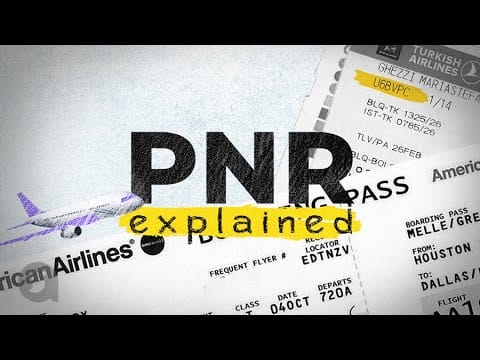
PNR explained
What is GDS?
Read the main article: How to Choose a GDS?
A Global Distribution System (GDS) is a computer network operating as a middleman between travel agents and numerous travel service providers. The three main GDSs to know about are Amadeus, Sabre, and Travelport.
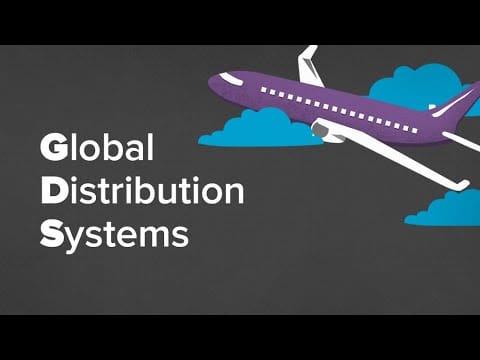
How airline distribution works.
A GDS aggregates flight information from the following sources:
- the Airline Tariff Publishing Company ( ATPCO ), which is the key vendor of fare-related content. Carriers cooperating with ATPCO can update their prices four times per day for domestic US and Canada flights and once per day for international flights;
- the Official Aviation Guide for Airways ( OAG ) and Cirium , which store flight schedules; and
- numerous airline CRSs, holding data on available seats and ancillaries.
Based on schedules, fares, and availability, the GDS creates offers and sends them to the OTAs and other travel platforms on their request. Travel agents connect to GDS content via manual terminals.
What is NDC?
Read the main articles: New Distribution Capability in Air Travel , NDC for Airlines: Key Providers and Implementation Scenario
The majority of flights are distributed through the mediation of GDSs, which force all the above-mentioned systems to exchange data via the archaic EDIFACT protocol. As a result, airlines can’t collect detailed information about passengers, nor can they provide feature-rich content and a wide range of ancillaries (like in-flight meals or excess baggage options) to their customers. On the other hand, they have to pay extra fees for GDS services.
New Distribution Capability (NDC) standard was introduced by the International Air Transport Association ( IATA ) in the hope of replacing the existing scenario. It allows travel systems to share data with each other via standard travel APIs and using the content-friendly XML protocol.
NDC enables carriers to access customer information, personalize user experience, and sell ancillaries and seats from one source, bypassing most of the third parties. Today, dozens of airlines and IT companies have adopted NDC capability, but GDS is still the main distributor in the industry.
Airline booking process steps
With some basics covered, let’s closely look at what happens between the moment of reservation via a travel platform and baggage reclaim at the destination airport. The whole process of this traveler/airline interaction can be divided into several major steps:
- flight search,
- flight booking,
- ancillary booking,
- using frequent flyer miles and points,
- payment processing,
- check-in and boarding, and
- baggage handling and reclaim.
In case you need to save your time, watch our video where we describe all the steps of flight booking.
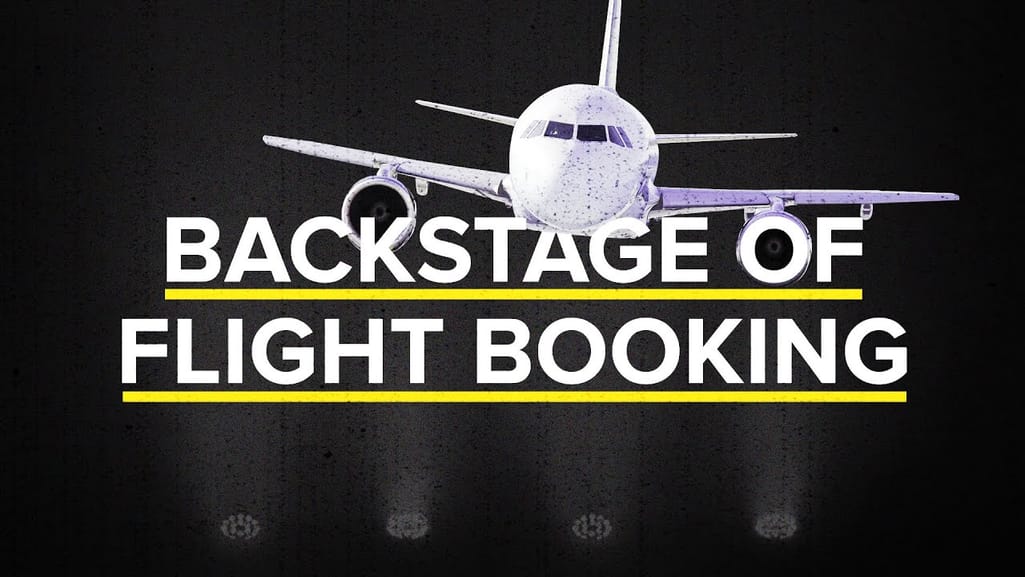
Flight booking process
Flight search
Today, a traveler can find a flight directly on an airline website or via indirect channels — OTAs, like Expedia , Orbitz , Travelocity , or Priceline or metasearch engines like Kayak or Skyscanner . Depending on the type of retailer, the search process will slightly differ in terms of technologies and results.
Via airline website. The website sends a search request directly to the airline’s CRS and then displays the list of available flights to the user, skipping the whole GDS part.
Yet, more often than not travelers want to compare fares from different carriers or need to book a complex itinerary operated by more than one airline. Obviously, they will opt for third-party platforms that aggregate offers relevant to a passenger’s query from multiple sources.
Via OTAs . Online travel agencies get flight information from
- air consolidators , which negotiate with carriers for bulk or net fares and then resell them to travel distributors, and
- partner airlines.
To maximize revenue, travel platforms use smart booking engines that filter and prioritize airfare deals according to predefined business and pricing rules. Watch our video explaining how this software benefits OTAs.

How booking engines work in OTA.
Via metasearch engines. Metasearch engines sift through deals across multiple OTAs, full-service carriers , and low-cost carriers (LCCs) which typically don’t distribute their inventory via GDSs. As a result, the visitors will get the widest possible range of flights available in the market.
On the dark side, a classical metasearch engine comes without booking functionality. Instead, it redirects travelers to a partner platform to make the next logical step.
Flight booking
While OTAs and metasearch engines are the preferred option at the search stage, the majority of travelers go to airline websites when it comes to booking. There are two main reasons for this.
First, when purchasing seats directly from the airline, it will be simpler, even from the technical perspective, to make changes to the reservation or cancel the flight. Second, travelers get access to a broader selection of ancillaries than OTAs typically provide.
No matter the source of booking, the airline CRS has to check if the flight product in question is still available for reservation. Then, it replies to the travel retailer with the status code HK (“holding confirmed”.) The alternative answer is UN, meaning that the carrier is unable to satisfy the request.
Another task of the CRS at this step is to create a PNR. In the course of booking, a retailer -- be it an OTA or airline website — collects personal data such as a passenger name and contacts and redirects it to the CRS. Once all mandatory details are gathered, the system generates a PNR number that works as an electronic address of the file in the database.
Ancillary booking
Ancillary revenue remains a major source of airline revenue, especially for low-cost carriers The list of additional services includes seat selection, excess baggage, extra legroom, or in-flight meals.
A traveler typically chooses ancillaries within the course of flight reservation. However, if purchasing the journey directly from the airline, extras can be added later. Passengers may access their bookings via the carrier’s website and make changes to them, using the PNR number.
In any scenario, the information on wanted ancillaries gets to the CRS in the form of special service request (SSR) codes, introduced by IATA. Each code contains four characters and is associated with a particular extra.
Some examples of SSRs are:
- EXST — for extra seat,
- KSML — for kosher meal,
- LSML — for low-salt meal, and
- PETC — for animals in the cabin, and
Not all ancillaries have their unique SSR codes, so they are defined as OTHS (others.) Some airlines use specific codes — to complement or even replace the IATA system. For instance, Qatar Airways offers transportation of falcons under the SSR-like code FALC.
To confirm an ancillary booking, a CRS checks if the service is provided on the particular flight and, as with to the flight booking, returns the status code — HK (“yes!”), UN (“no!”), or some other. The information on ancillaries is added to the PNR (even if the carrier declined the request.)
Using frequent flyer miles and points
Members of a frequent-flyer or airline loyalty program can use earned miles or points accumulated from previous flights for purchasing extra services from airlines. These points can be exchanged for discounts or benefits, like upgrading to business class. To earn customer loyalty, CRSs reserve a particular number of places for frequent flyers.
Passengers can either log in via their accounts while purchasing tickets from an airline website or get a loyalty program participant's number to book from a third-party.
Payment processing
Intention to fly must be eventually backed by money. In other words, passengers have to pay the fare for use of a seat plus taxes and the cost of ancillaries (if any.)
The financial operations between passengers and low-cost carriers can be performed via payment gateways — third-party services that not only process transactions but also ensure data safety. Yet, if full-service carriers, GDSs, and OTAs are involved, things become far more complicated. In this case, money must flow through IATA’s payment processing mechanism called the Billing and Settlement Plan (BSP) or its US analogue, Airline Reporting Corporation (ARC.)
Read more about these two financial entities in our dedicated article Airline Reporting Corporation and IATA Billing and Settlement Plan: How They Work .
Once the payment is confirmed, the traveler receives a flight itinerary and PNR number via email. That’s enough to track the flight status, cancel the trip or even, in the case of direct booking, modify the future journey and add ancillaries. However, to board the plane, people need tickets.
Ticketing and booking are two separate processes. Booking just holds the seat on the plane. Ticketing means that the seat is paid for and the passenger has the right to take it during the flight.There is a certain time lag between these steps, even if a traveler pays for the trip immediately, as most OTAs and LCCs require. It usually takes up to three working days to verify payment details and finalize money transmission.
To issue an e-ticket — or individual electronic receipts linked to the PNR — the company must be certified by the above-mentioned BSP and ARC. Not all air travel retailers can afford this. Instead, they ticket flights via accredited partners — like big OTAs, air consolidators, or host travel agencies .
And what if a trip consists of several flights operated by different airlines? For such cases, carriers strike a special commercial agreement called interlining and issue a single ticket covering all segments of the itinerary. Also, the Super PNR is created to link pieces of the journey in one record.
In any case, the e-ticket with the passenger name and related PNR number is finally emailed to the traveler. If for some reason, the booking can’t be ticketed, the travel supplier has to offer an alternative flight or pay a full refund.

Emirates e-tickets example. Source: Scribd
Check-in and boarding
Here we deal with the airline’s DCS or the departure control system. This module of the PSS is connected to the CRS and airport devices like self-check-in kiosks, airport agents’ software, baggage drop, and even immigration control. The DCS processes all check-in and boarding-related procedures, which starts with ticket validation. Also, this system is responsible for entering customs and border security reservation, as well as aircraft weight optimization and cargo handling.
During check-in, a traveler must provide their PNR and name so that the system can match it with ones stored in the CRS and assign a seat. This procedure slightly differs online and offline.
Online check-in . Online check-in usually becomes available 48 hours before the flight, but it depends upon the airline. A traveler enters details from an e-ticket at an airline website or an app and gets access to an aircraft seat map to choose a particular seat. If a user doesn’t select it, the system randomly assigns a free one and issues an electronic boarding pass. The same principle works for check-in kiosks.
Airport check-in. In this scenario, a person brings an e-ticket to the airport agent at the check-in counter, so that they can enter the details and reserve a seat on a seat map.
After the check-in, the departure control system generates a boarding pass that finally entitles passengers to get on a plane. It can be printed off or just downloaded to the mobile phone. The document contains a QR code that works as a unique link to the traveler’s flight information. As the passenger proceeds to the airplane, a QR code is scanned and PNR status changes from “checked-in” to “boarded” and, finally, to “flown.”

Boarding pass sample. Source: Lastbreach
Baggage handling and reclaim
A plane has landed at the destination point, and it seems like this is the end of a journey – unless a passenger’s baggage is lost. To avoid this, the airline’s DCS generates and prints out bag tags with ten-digit numeric codes, also represented as a barcode. The airport’s baggage handling system scans these barcodes to sort and track the baggage.
At the same time, the codes appear in IATA’s baggage tracking system called WorldTracer . Any passenger can check the status of their traveling property by entering their last name and the ten-digit code assigned to the bags.
A few more words on flight booking
Since there are no ticket agents anymore and you don’t need to call them to reserve a paper ticket, today’s flight booking pipeline is considered to be simpler than before. But still, a single booking requires a number of different operations, all bound to one another. Most of these processes remain overcomplicated by numerous connections to different services, systems, and distribution channels. As innovations are adopted by both airports and airlines quite slowly, there still are GDSs and multiple airline flight booking APIs to ensure seat, ancillary, and fare distribution.

How to Create a Better Travel Booking Process

Even the most intrepid road warrior can use a helping hand. That’s why so many business travelers work with administrative assistants to manage their trips. Admin support can take a significant amount of work off a traveler’s plate, but it can also add some complications.
Without a system for collaborative trip planning, one of two things happens:
The admin has to check every booking decision with the traveler.
The admin is never informed of a traveler’s preference, and has to resort to guessing. In practice, this usually means playing it safe by selecting familiar options regardless of cost. The Ritz might be $200 more expensive than a hotel across the street, but if you were arranging a trip for your boss, would you take any chances?
In the first case, time’s wasted. In the second, money is. Without clear guidelines, travel bookers are put in a losing position.
If you work with an admin to manage your business trips, or if you book trips on behalf of colleagues, there are things you can do to avoid needless complications. The more up-front communication the better. By taking a few minutes to document travel booking “best practices,” you’ll:
Save time by cutting down on back-and-forth.
Establish what factors are most important for the traveler’s comfort and convenience.
Encourage use of cost-effective options that fit within the traveler’s parameters.
Here’s what you need to create a seamless experience for admin-supported travel planning .
Traveler Profile
The traveler profile gathers all the information booking sites require to complete a transaction. This includes a traveler’s legal name, date of birth, TSA known traveler number, contact information, and frequent flyer numbers. If a personal credit card is used to book business trips (as opposed to a shared corporate card), the traveler profile form can also include billing details.
Traveler Preference Survey
A traveler preference survey is an easy way to communicate flight and hotel preferences to whomever is booking a trip. It not only shows which brands the traveler is open to using, but also identifies underlying booking priorities: the amenities to look for, the traveler’s level of flexibility with regard to airline and hotel choice, even where he or she likes to sit on the plane. With a comprehensive overview of these preferences in hand, an admin can know the traveler as well as they know themselves (at least when it comes to booking business trips).
Business Trip Booking Request Form
Having a standardized format for trip booking requests makes life a lot simpler for an admin. It reduces the chance of miscommunication and cuts down on back-and-forth during the trip planning process. Essentially a template for outlining a desired itinerary, a booking request form should take less than two minutes to fill out.
If someone books business trips on your behalf, or if you’re an admin who helps arrange travel for a colleague, you’ll love Rocketrip’s Essential Travel Planning Toolkit. Get your copy using the link below, and read about Rocketrip’s new Copilot feature to see how we motivate affordable travel booking.
{{cta(‘eb47b8e4-b45d-49d7-a88e-0fd460294086’)}}

Read This Next

The Best Travel Management Software for 2022
Business travel accounts for about 20% of the total expenditure for global tourism. Travel management software can help your company save money on employee business travels. It can also enhance employee safety during travels by notifying your company of any health, environmental or other risks impacting certain areas. There…

Best Business Suitcase For All Types of Travel
The best business suitcase is one that’s easy to carry and gives you a professional look. Make your business travel less frustrating by choosing the right suitcase for your needs. Tips for Choosing the Best Business Suitcase Are you looking for the best suitcase for business use? Here are some…

5 Tips for Business Travel Safety
Your employees expect you to put their health and well-being first when you send them on business trips. With an ongoing global pandemic, it’s vital to address any questions staff might have about business travel safety. Fortunately, some modest research can help you and your organization plan business-critical trips without…

In this post we’ll look at some of the key ingredients that make the online travel booking process easier for customers.
It’s doubtful that the perfect booking process actually exists (please tell me if it does), but it’s something sites should at least be aiming for. However, there are some excellent features on some travel sites, and I’ve compiled some of the best here.

So, the ideal travel booking should include the following…
Table of Contents
1 An Easy to Use Search Box

2 Great Presentation of Search Results
Search results pages are equally important. Results should be presented clearly and they should be easy to filter and manipulate.
Key features of good results pages include:

- Sorting of results. The ability to order results according to preferences is vital. This may be price and duration of flights, departure times and more.

3 Provide Inspiration for Travellers
While some visitors will arrive at a travel website with a clear idea of where they want to go and when, others will be more flexible. Perhaps they have a week free in July and want to go somewhere warm, but are open to different destinations.

4 Make Sure It Works for Mobile Users
Mobile is now essential for travel sites, and so the booking process needs to work on mobile just as well as desktop.
The following stats from Adobe should underline this point.
- 52% of travel related browsing takes place on mobile.
- Despite the browsing activity, just 21% of travel sales took place on a mobile device.
This underlines the point that mobile is crucial in the holiday research process, but the sales stats suggest that there is still work to be done to improve the booking process.
Of course, sites should be optimized for mobile, but that’s not enough on its own. Every aspect of the booking process should be made easier for mobile visitors to use.

5 Use Images to Inspire
Images need to be used to sell the benefits of destinations, but also to provide key information for users.

6 Show User Reviews
User reviews provide an extra level of detail for potential travel bookers and, crucially, add an extra layer of trust.
A common approach now is to use reviews from TripAdvisor on travel sites, as eDreams does in the example below.
The combination of average review scores with the actual reviews within the listings works well. Shoppers can also filter search results by average user review scores.

7 Be Upfront About the Total Cost
Hidden charges are a real source of irritation for online shoppers, and travel websites have been some of the worst offenders on this score.
Car rental sites are a bugbear of mine, as rental firms seek to squeeze as much money out of customers as they can through extras like child car seat hire, insurance excesses and the practice of charging over the odds for fuel.
Holiday sites have been guilty of this in the past, as this example from Hotels.com shows , but now online shoppers are generally more savvy about this, while ‘tricking’ customers is likely to lead to bad publicity.

8 Go Easy on the Cross-Selling
There’s nothing wrong with sending cross-sell emails , and many travellers will appreciate the option of being able to book car hire and other services while they’re booking.
However, it’s important not to overdo it. Also, forcing users to interact with extras can be an annoyance.

9 Provide Contact Options During the Booking Process
Travel bookings can be expensive and complex- for many people they may be the biggest purchase they make that year – so it’s natural that people may have doubts during the booking.

10 Add a Touch of Urgency
Ecommerce sites can use urgency in a number of ways, perhaps with a time-limited special offer, a threshold for next day delivery, or messaging around low stock levels.
For travel sites, urgency is a useful tactic to employ, as the date of the booking adds an obvious deadline for decision, while ticket and price availability changes quickly.
It’s important to note that urgency should be used honestly. Telling shoppers that there are just two seats left on a flight they’re considering is a useful piece of information, and one that may just help them to come to a decision more quickly.
However, if they see such details on every listing, the effect is diluted and trust in the information provided will be lost.
This hotel listings page from Hotels.com provides a couple of strong examples of urgency.

11 Provide a Range of Payment Options

Indeed, many now offer PayPal as well as card options, but others offer a wider range of methods. KLM offers 10 different options, depending which country flights are booked from.

12 Focus on Form Usability
Forms are a big part of the booking process, and any usability issues here can have a negative impact on conversions.
Travel booking forms tend to be longer than the average e-commerce form, as users need to enter details for each traveller, choose seats and in-flight meals, and so on.
The key is to minimize form abandonment through good design and composition of the form.
Here are a few ways to make forms more user-friendly.
- Keep forms as short as they need to be. As this article from UX Booth says, it’s not simply about making forms short, as many other factors influence form usability.Forms should be as long as they need to be, but it pays to avoid adding unnecessary fields. The Question Protocol can help here.

- Provide a persistent reminder of order and total cost. We can see this in the Thomson example above – this reassures customers that the flight times and dates are correct, and the total price.

I could list more tips, but overall it’s about providing the best possible user experience for your users.
Obvious sources of friction within forms can often be identified through analytics or user testing, and form design should seek to minimize these issues. You should also consider your mobile form design strategies as well as desktop as the two are vastly different and require different optimisations to be applied.
Form usability is absolutely vital but often overlooked, and it represents some of the quickest and easiest ways to reduce abandonment rates.
The perfect booking process may not exist, though some sites are clearly incorporating more of these features than others.
Travel booking can be a lengthy process and, out of necessity, users are required to enter a lot of information at times. However, a focus on creating the best possible user experience can do a lot to reduce abandonment rates.
Request a Demo of Our Booking Abandonment Emails
Find out how booking abandonment emails could work for you.
⬛️ 2023 Black Friday Ecommerce Strategy & Stats Report
This FREE ebook gives you the methods, solutions & trends for building a high-converting remarketing strategy for Black Friday

Speak to an expert
Learn how to convert your online audience into revenue with our experts.
Subscribe To Our Newsletter
Stay up-to-date with the latest from our award-winning blog.
Featured Posts
Graham Charlton
Graham Charlton is Editor in Chief at SaleCycle. He's been covering ecommerce and digital marketing for more than a decade, having previously written reports and articles for Econsultancy. ClickZ, Search Engine Watch and more.
Related Articles

The psychology behind loyalty programs: understanding what drives customer loyalty

The fundamentals of conversion rate optimisation (CRO)

Cart Abandonment Emails: 12 Best Practice Tips
![travel booking process Valentine’s Day Ecommerce Tips and Trends [2024 Strategy]](https://www.salecycle.com/wp-content/uploads/2019/01/valentines-ecommerce-1.png)
Valentine’s Day Ecommerce Tips and Trends [2024 Strategy]

How Gaming Sites can Increase Customer Registrations

10 Last Minute Fixes for Online Retailers Before Black Friday

How To Prepare For Black Friday 2023

SaleCycle and LINK Mobility Join Forces to Revolutionise Customer Engagement
![travel booking process How SaleCycle helped Vodafone increase their online sales by an additional 2,000 additional sales per month [Extended Version]](https://www.salecycle.com/wp-content/uploads/2023/08/vodafone-banner.webp)
How SaleCycle helped Vodafone increase their online sales by an additional 2,000 additional sales per month [Extended Version]
Find out how salecycle can help you.

Copyright © 2024 All Rights Reserved
Connect with Us

UK: +44 20 3318 6826 US: +1 929 207 4710 FR: +33 1 76 43 12 23 ES: +34 911 23 97 58 IT: +39 02 9475 9054 DE: +49 160 98060390
- Privacy Policy
- Cookie Policy
- Service Privacy Notice
Subscribe To Our Monthly Newsletter Stay up-to-date with the latest from our award-winning blog.
Privacy Overview

How To Drive Travel Conversions With Your Direct Online Booking Process
- Using WeTravel
In the past, making a travel booking meant phoning up a travel agent or popping into their office. The agent would lay out the options and process all the reservations on behalf of the traveler, who would then walk out with their itinerary or wait for an email to follow.
Today, many travelers want to handle their own bookings. Because of technology and the internet, they now have the tools to research, plan, and secure reservations.
You can also bet that they expect the travel booking process to be fast, secure, and simple to use. Any friction in the experience and they'll be walking out the metaphorical door empty-handed and heading over to your competitors' website.
Winning them over means that you need to offer the best possible travel booking experience.

Just recently we covered tips on how to optimize your booking pages to convert customers. We also took a look at finding the right balance with OTAs and encouraging more direct bookings . In this post, we’ll focus on how to drive conversions with a direct online booking process and easy check-out.
Getting this right means that prospects will know exactly what steps to take when they’re on your booking page, as well as feel secure about submitting their payment information.
Receiving a confirmation after completing the booking steps is the final step to validate the process and provide a summary of their reservation information.
Key Features That Drive Conversions In The Travel Booking Process
First, let’s take a look at the ideal booking flow process, as this guides the sections we touch on below.
- Clients should be able to easily find the information they need on your booking page
- They should be able to choose and select package items as they need
- If they need to change or add to their booking, this should happen seamlessly
- Space to input their relevant personal details
- See a summarized booking with selected items and total price
- Securely pay in a currency of their choice with several payment options
- Receive an instant confirmation with all the relevant details
If you’re a WeTravel client, then this process is automatically added to your booking page and check out.
If at any point this process becomes too overwhelming for the client, or if there’s something they’re unsure of, it could lead to them abandoning the process.
Ideally, you want to prevent this from happening altogether. Or, if it does, then you should re-engage them quickly so that you don’t lose their interest.
Now let’s look at the main sections in more detail.
Trip Page and Book Now Button
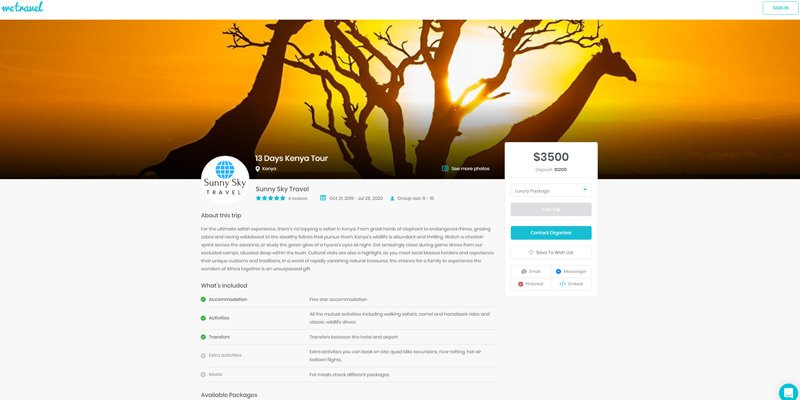
The trip page gives customers an overview of the trip they’re interested in buying into and allows them to make basic package selections.
There’s also a Book Now button or reservation box so that people can start the booking process themselves.
Without it, clients have to contact you to make a reservation. This may drive them to leave the page and not come back. It’s all about instant gratification.
With WeTravel, tour operators have several options to create a self-service travel booking process for your clients. Everything is customizable and you can:
- Create a booking page with an embedded checkout and generate a direct link
- Embed a Book Now button on your website
- Embed your trip on your website
All of these options allow your clients to make their own reservations. There’s no need for them to contact you to complete the process.
Reservation Form
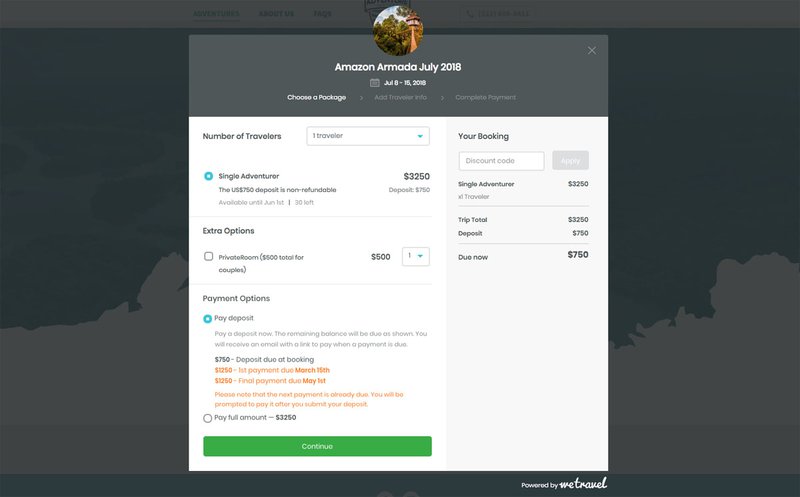
Reservation forms in the travel booking process provide you with the information you need about the traveler. It also reassures them that you will be able to identify their reservation.
Friction at this point can negatively impact on conversions.
Although travel booking forms typically need to collect more information than your average online payment form, it’s still possible to optimize them and minimize abandonment through careful design.
Using WeTravel, you can choose what details to collect from travelers and create custom fields.
To make the forms more user-friendly when customers are booking:
- Provide visual appeal to liven up the form
- Keep forms as short as possible and only collect necessary information
- Constantly display the package selected and total cost
- Provide inline validation on the form, so that customers know right away when there’s a mistake
- WeTravel provides simple form progress indicators to show clients how far they are in the process and what’s left to complete
Real-Time Payment Processing
Submitting a payment is part of order fulfillment for travelers. When they pay a deposit in real-time, the reservation is confirmed and it becomes official that they have secured their spot on the trip.
This step must flow on from the previous one, as a break in the process may leave customers wondering why this happened.
They can lose trust in the experience if they’re directed away. They no longer know whether they’re paying the right person, or if perhaps the system has been hacked and someone is trying to steal their money.
Some of the best practices for this part of the travel booking process is to:
- Display that transactions are secure and encrypted
- Offer several payment options including bank transfer and debit/credit card
- Continue to show the details of the package and total cost
- Link to Terms and Conditions, as well as cancellation policies
- State that customers agree to the above upon clicking confirm, or provide an inline box that needs to be checked
Confirmation
Sending a confirmation is the final step in the process and completes the travel booking experience.
Using WeTravel, a confirmation email will automatically be sent to the person after completing their booking.
It provides them with a summary of the reservation they have made and can include a welcome message. You can also add in details of optional extras that you are selling, such as travel insurance, and provide a CTA to manage their booking.
All in all, this helps to validate the booking for your clients and reassure them that you have their information and deposit.
It’s a good idea to let them know what’s next, i.e, when will you be in contact again, or what can they expect in the time leading up to their trip. It’s your opportunity to start the relationship off on the right foot.
Final Thoughts
The travel booking process is the pinnacle of your sales and marketing efforts. If you've spent the time nurturing clients through the sales funnel, the last thing you want to happen is for them to abandon their purchase due to a poor booking and check out experience.
As a WeTravel client, our booking and payment solutions platform offers the perfect customer journey and gives your clients a seamless way to complete their reservations.
If you’d like to watch WeTravel in action, then check out the short video below.
New resources, straight to your inbox
We’re committed to your privacy. WeTravel uses the information you provide to us to contact you about our relevant content, products, and services. You may unsubscribe at any time.
About the author

Related Posts
Best practices to get more google reviews for your travel business, best newsletters to help you grow your travel business, building a digital presence for travel companies - introduction.
What do customers expect in the online booking process?

By Kevin Tjoe — 30 Sep 2021
Customer Expectations online booking process travel booking procedure
What does the perfect online booking process look like for your customers? You could market your tourism business with great success and amazing reviews – but if your booking process isn’t simple and smooth then you could lose customers at this crucial point. Let’s consider what customers expect in an ideal travel booking procedure , as well as some implementation tips.
Guest expectations for the online booking process
24/7 booking capability .
An online process enables your customers to book at 2am, 9pm or at the last minute if they choose, capturing their interest whenever it suits them. As such, live availability and booking is a must: whether customers are on your website, a review site such as TripAdvisor or online travel agencies such as Booking.com or Expedia. Whenever customers happen to click on that ‘Book Now’ button, you won’t want to miss that chance.
Clear answers for any customer questions
It’s crucial to step into your customers’ shoes and provide the answers they might be seeking as they work through the online booking process. Will their elderly parent or children be able to join them? What happens if the weather turns out to be terrible on the day? Answer these types of questions pre-emptively, and you’ll vastly improve your chance of a successful booking. For example, aim to include:
- A clear and compelling activity or city tour description
- Images to build excitement and further explain the experience
- Transparent pricing
- What to bring, where to meet and which amenities to expect
- Any health or fitness requirements
- Your tour operator cancellation policy , COVID-19 policy and inclement weather policy as appropriate. Learn more about how to write a cancellation policy.
A smooth and snag-free booking process
Convenient booking is the whole point of an online process . Nobody wants to spend half an hour completing their booking or filling in twenty form fields on one page only to be faced with multiple errors. Be sure to carefully consider which customer information you actually need, and choose an online booking system that will guide customers through the process step by step.
Follow-up confirmation and reminders
Once customers have committed to your tour or activity, they’ll want reassurance that their booking and payment have been successfully received. A branded, automated confirmation email can provide this reassurance and inform all of the guests in the booking group. You might also wish to send out an automated reminder a day or two before the experience; potentially with a liability waiver for guests to sign electronically at their convenience. Bookings and waivers can be easily connected when integrating services such as Rezdy ’s online booking software and Wherewolf ’s digital waivers.
What makes a customer abandon a travel booking partway through?
The tourism and travel industries can have some of the highest abandonment rates around – even as high as 97% for cruise and ferry sites! Address the following key factors to keep your abandonment rates as low as possible:
- Minimising technical issues by using a reputable online booking system
- Providing clarity around pricing to avoid fee shocks
- Ensuring your booking process is efficient and hassle-free
- Providing multiple payment options for customer convenience
- Taking action on abandoned cart notifications to recapture interest.
How to create a friction-less online booking flow
If your goal is to increase tour bookings this year, you may want to start by evaluating your website. Each element of the website should be used to encourage travellers to book your products, and to book them now. The booking flow should be as seamless as possible so travellers can find the information they need and instantly book. Here’s how to create a friction-less online booking flow:
Add a booking button to every landing page
Your website may have multiple landing pages, all with additional information about your company and the products that you offer. These landing pages simply must have a booking button on them. You never know which tidbit of information or data will convince a traveller to book one of your tours. Your online booking solution should include a visible booking button that can be added easily to any website landing page that you create. With a ‘Book Now’ button on every page, you’ll be able to take advantage of the moment that the website visitor feels compelled to become a customer.
Don’t bury the booking button
Adding the booking button to the page code is not enough. You’ll also need to be strategic about where you place the booking button on each landing page. It should be near the top of the page design so that it’s visible during those first few seconds that a website user is scrolling the page.
Include buttons in areas where it will feel natural to click — perhaps right under a brief tour description, or next to a high-resolution image of people enjoying your tours. The booking button should be easy to spot in a prominent location in order to be effective.

Enable booking capabilities on social platforms and SERPs
Your website shouldn’t be the only place where your prospective travellers can book your products. Many people are now using social media to book directly with companies; however, others may prefer to book directly from the search engine results page (SERP). Ensure that you implement an online booking solution that allows you to accept direct bookings through Facebook, Instagram and even with Google Things to do – all of which help your website to attract customers that google tours and activities similar to yours.
Travellers are becoming increasingly accustomed to the convenience of advanced technology. Many travellers now prefer to use their smartphone assistants and devices to book their tours and activities for them. Keep up with this demand by investing in a booking solution that works naturally with the latest technology and trends.
Your customers shouldn’t have to work to book your tours and activities. The online travel booking procedure should be made as simple as possible for them, so you won’t miss out on that pivotal moment when they want to finalise their reservation. With the right technology in place, you can simplify the booking process, boost your bookings and provide an amazing customer experience.
If you found this article useful, then you might like to subscribe to Rezdy blog updates for more marketing tools and resources created for businesses just like yours. You can also book in a free demo to explore Rezdy booking software, or start your free 21-day trial today.
Start a 21 day free trial
Enjoy 21 days to take a look around and see if we are a good fit for your business.
No obligations, no catches, no limits, nada
How to Create the Best Booking Flow on Your Website
By Kyla Steeves
Share this article:
- Facebook icon
- LinkedIn icon
- Twitter icon

A traveler visits your tour and activity website for many different reasons — like to compare prices, get ideas for an upcoming trip or learn more about your business. While you want them to book with you, they have a wide range of intentions. That’s why it’s challenging to align their actions with your ultimate goal. But there’s good news! It’s possible with granular, yet pivotal tweaks to your booking process.
You might already know how to use your website to make a great first impression— like responsive design, fast loading time, simple navigation and clear calls-to-action. But even when a traveler decides to take action and book, they can leave at any point if the booking process is too tricky.
To increase travel conversion rates , it’s essential to have the best booking site design that matches a traveler’s actions every step of the way. What does that look like for tour and activity operators?
In this article, we break it down for you. Let’s get started:
Setting up a travel booking process
1. research your target audience.
Before designing your booking process, consider your target audience. Who do you want to attract? Where do they live? What’s the purpose of their travels? Are they traveling solo or with a group?
Discovering these answers will help you understand your average guest — their needs, goals and online behaviour — which will give you an idea of how to successfully lead similar personas down the booking funnel.
Start with observing the first question your guests ask over the phone. Do they immediately want to know the price? Or what times and dates are available?
The first question you answer over the phone should be the first question you answer online.
For example, if you often hear, “do you have a tour available on this date? ”, then you should have an availability calendar as the first step in the online booking process.
Quick tip: Display a book now CTA in the header of the homepage to make for easy navigation. That way, travelers visiting your website with the sole intention of making a reservation can do so quickly — which is handy for those booking with a mobile device.
2. Include a browse page for specific tours
It’s likely you have more than one tour and activity for a guest to choose. While it seems like a good idea to list everything on the homepage, it can be overwhelming for visitors — especially if they’re just browsing.
Instead, you should break your items into categories. In doing so, you’ll help a traveler who has a general idea of what they want, find a specific tour they’re eager to book.
List the categories on your homepage, and then take the visitor to a browse page of that category depending on which one they select.
As an example, let’s look at The London Experience which offers a variety of tours and activities that make a traveler’s trip to London special.
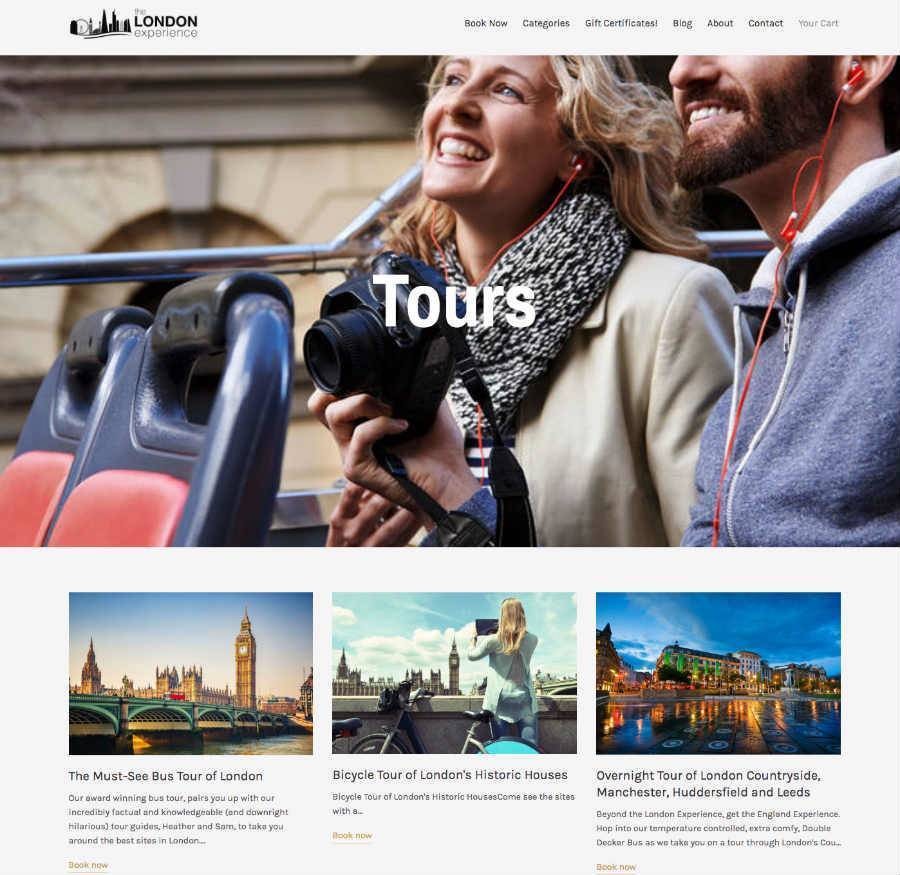
Let’s say a traveler is only interested in booking a tour. With a tour category page, a traveler can narrow down their decision by selecting from only the tour items. Now, there’s a better chance they’ll find something that appeals to them and fits with their itinerary.
Quick tip: List five or fewer options on every category page. Visitors might find too many choices exhausting when trying to make the best decision for their travels.
3. Lead down the booking funnel
Once a visitor has decided on a tour, it’s best to lead them quickly down the booking funnel . If they want to book, then you shouldn’t delay them any further with unnecessary information.
During a phone booking , there are specific details you’ll ask a guest right away — like “how many adults and children,” or “what time do you want to go?” Online booking works the same way.
Have the guest tell you the date, time, and the number of guests before adding the tour to the cart. These details should be big, clickable buttons that pop out on the page.
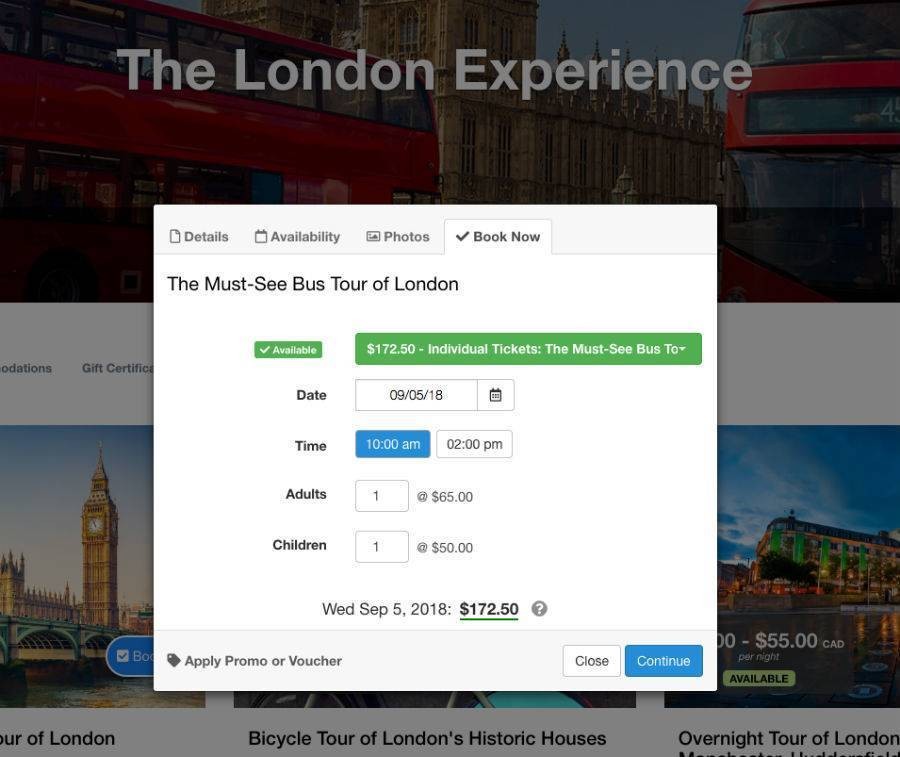
Quick tip: Think of your target audience when it comes to the language you use. For example, instead of using the term quantity, use something that is more relevant to your business — like guests, adults, players, etc.
After they finish, present them with the subtotal (in the currency of their home country) and then make the Add to Cart button easy to identify and click. Again, think of your language here — try something like Book Now instead.
4. Upsell on the booking form
At this point, you’ve attracted a traveler enough to become a guest. Now, it’s time to delight them by providing an option that will boost their experience.
With a booking form, it’s best to show the details again so the guest can make sure everything is correct. While they’re looking this over, present them with other add-ons. It’s likely they want their tour to be unique — which means there’s an opportunity to get them to add to their booking.
But don’t just present them with anything from your list of offerings. Think about what will make their tour special.
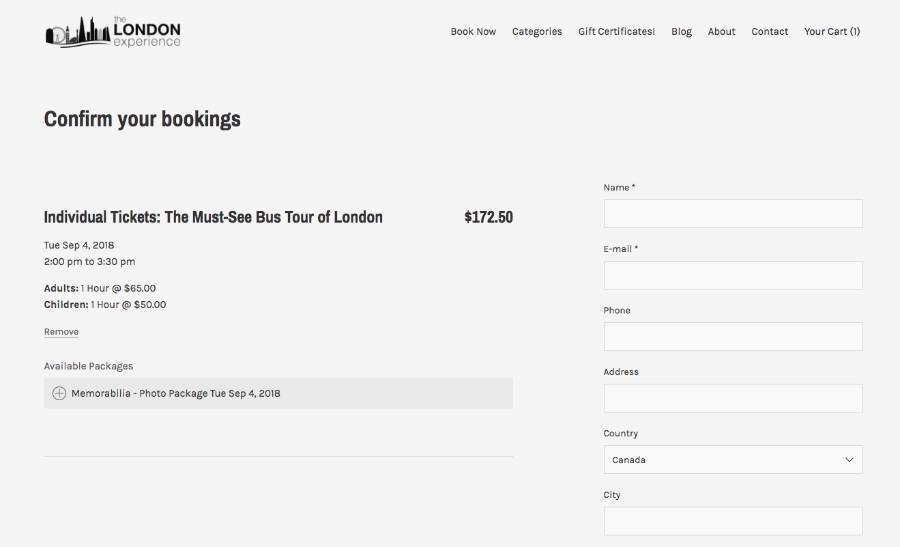
For example, let’s say a guest has chosen to do your hiking tour in the hottest time of the year. If they’ve had previous hiking experience, they likely know how warm they’ll be after a few hours of switchbacks (or you can tell them that in the tour description).
So it’s a great idea to offer them something additional that will allow them to cool off afterwards — like a canoe trip and dip. If the add-on compliments their initial tour, they’ll be more tempted to include it in their booking — which means a bigger sale for you.
Quick tip: Keep the required fields on the booking form to a minimum. Ask them only what’s necessary — like name and contact information. Too many form fields are a turn-off, especially for mobile users. If you need more details from them, you can collect it on the guest form after check-out.
5. Avoid adding extra fees on the invoice
A visitor isn’t necessarily hooked when they reach the invoice. They haven’t paid yet. There’s still a chance they’ll cancel their actions.
But why would someone abandon the cart so close to the end? Especially after taking the time to find a tour and fill out the form?
One reason is that the final invoice contains additional fees. Extra payments are often unexpected and might confuse the guest, or worse, cause them to feel distrust.
Not all surprises are good ones. That’s why it’s best to include the fees in the subtotal from the beginning.

What if the fee is unavoidable — like a fuel surcharge? Well, you can treat it like a charitable donation. Be transparent about the add-on by explaining what it’s about. Customers are more likely to accept a fee when they understand the reason.
Quick tip: Make sure any discounts stand out on the invoice. That way, if the visitor is wondering if there are any deductions — like an early bird discount — you already answer the question for them.
6. Send an automatic confirmation email
A customer gets an instant receipt when they purchase a product at the store. For online booking, it should be no different. Money is a point of tension and worry. Most guests want a booking confirmation and proof of payment right away.
There’s a huge cause for concern when the confirmation is delayed, or there isn’t one at all. The guest might email you a dozen times to make sure everything is good to go or show up thinking everything is, when in fact, it’s not. Both these scenarios make for a poor experience before the actual experience.
A booking confirmation lets both you and the customer know the booking is valid. It’s also an excellent opportunity to build rapport by thanking the guest for choosing your tour. Or give them another chance to review the booking details, so they don’t arrive with a curveball like, “oh…we actually wanted two gluten-free lunches.”
Quick tip: You can save time at check-in by also sending a built-in digital waiver with the receipt. That way, your guest can sign it online at any time before arrival.
It’s time-consuming to send confirmation emails manually. But with Checkfront, you can set up emails to send automatically — while keeping it personal for every booking.
7. Collect guest information after payment
Long lines at check-in are a pain for everyone. Instead of handing out paper forms at reception, it’s best to let guests fill out the form online. That way, everyone can jump right into the adventure as soon as they arrive.
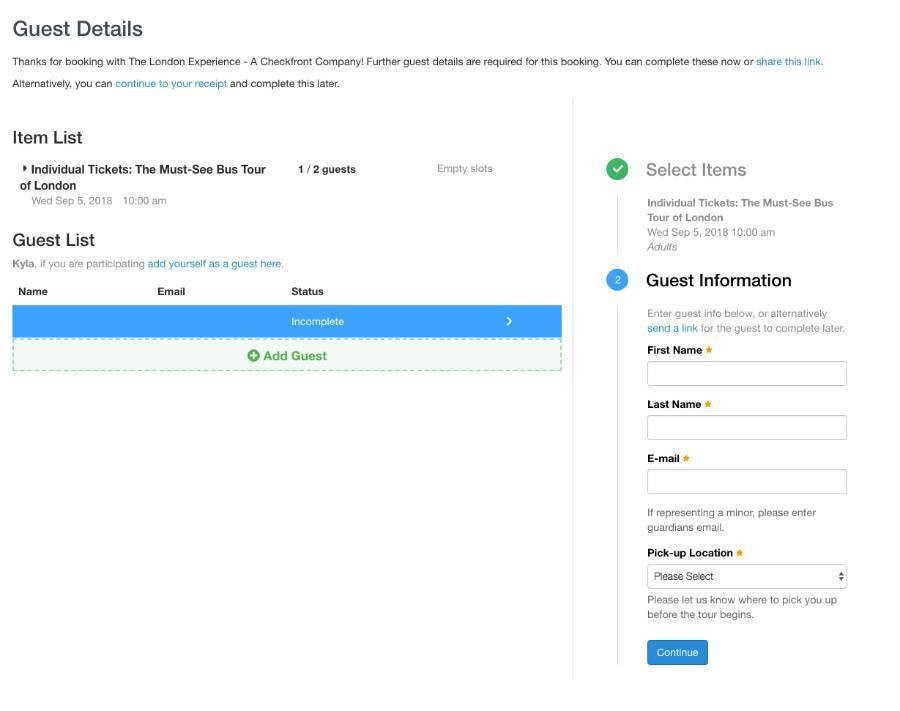
Since a guest form takes time to submit, present it after the reservation is completed to avoid disrupting the booking flow. Give two options to the person making the booking:
- Enter the information for each guest.
- Send a link for guests to complete later.
At this point, the booking has been made, and there’s time for guests to submit their details.
Quick tip: Make sure to ask for information relevant to the tour and activity — like height, weight, dietary restrictions, etc. With Checkfront’s Daily Manifest , you can get an overview of guest details for any booking and prepare ahead of time with the information received.
Final thoughts
A smooth and straightforward booking flow is essential for getting more online sales. Just remember to track and analyze the changes you make until you find a booking flow that works for you.
PS. Checkfront comes with the best booking flow for tour websites.

Start your free 21-day trial!
Online bookings. Flexible pricing. Outstanding support.
Related Articles

How to write ATV tour descriptions that drive bookings (with examples)
Learn how to write ATV rental descriptions with SEO-ready language that help you sell more bookings
- Marketing Strategies

Easy & effective pricing tactics for activity and rental operators
Ever wondered why at the movie theatre you’re likely to opt for a Large Popcorn instead of a Small or…
Search Blog
Subscribe to our newsletter.
Get tips and strategies to grow your business and impress your guests.
Blog Categories
- Booking Management
- Business Tips
- Guest Experience
- Operator Highlights
- English (CA)
- Deutsch (DE)
- Deutsch (CH)
Top 10 Online Travel Booking Systems in 2024
What is an online travel booking system, main features of an online travel booking system.
- A user-friendly interface that enables users to search for and book travel services based on their preferences.
- Secure online booking and payment processing.
- Real-time availability and pricing information.
- Travel itinerary and reservation management tools.
- Customer support and traveler assistance.
- Reporting and analytics capabilities.
Best online travel booking systems for B2B
Online travel booking systems for companies, 1. travelperk.
TravelPerk main features
- An intuitive, user-friendly online booking platform -- all traveler data, preferences, and loyalty points are stored.
- Integrated travel policy and approval flows .
- A simplified travel expense process with real-time expense reports.
- FlexiPerk , an add-on that allows users to cancel their travel plans up to two hours before departure with a guaranteed refund of 80%.
- 24/7 business travel assistance with a target 15-second response rate from the 7* customer care team.
- A VAT recovery solution to help businesses save up to 25% on business travel expenses.
- TravelCare , a travel safety and alerts system.
- Centralized invoicing for all business travel, eliminating the need to send invoice requests and reminders.
- A vast catalog of integrations with third-party software .
- Trip Assistant -- a mobile app available on iOS and Android -- that stores all trip information in one place, even when you’re offline.
How customers rate TravelPerk
- G2 rating : 4.5 / 5 stars, based on 1,533 reviews (as of February 2024)
- Capterra rating : 4.8 / 5 stars, based on 402 reviews (as of February 2024)
TravelPerk pricing
- Starter: The first 5 bookings each month are free, with a 5% booking fee thereafter.
- Premium: $99/month with a 3% booking fee. Includes concierge services for special requests and savings of up to 25% with VAT-ready invoices..
- Pro: $299/month with a 3% booking fee. Includes unlimited policy and approval workflows, unlimited budgets by cost center, and access to negotiated rates.
- Enterprise: Designed for enterprise businesses that need customized requirements. To find out more about this plan, get in touch with an expert .
?)
Start saving money on business travel for your company today!
2. sap concur.
?)
SAP Concur main features
- Automated expense reporting and reimbursements.
- Self-booking for flights, hotels, trains, and car rentals through the platform.
- Real-time alerts, notifications, and reminders for traveling employees.
How customers rate SAP Concur
- G2 rating : 4 / 5 stars, based on 5,996 reviews (as of February 2024)
- Capterra rating : 4.3 / 5 stars, based on 2,004 reviews (as of February 2024)
SAP Concur pricing
Click below to compare travelperk and sap concur’s features and benefits, travel booking systems for travel agencies.
?)
Ezus main features
- Automated trip costing and dynamic pricing options.
- Creation of mini travel websites for each project.
- Centralized customer relationship management software (CRM) features and travel portal for visibility into customer history and upcoming opportunities.
How customers rate Ezus
- G2 rating : 5 / 5 stars, based on 11 reviews (as of February 2024)
- Capterra rating : 4.6 / 5 stars, based on 33 reviews (as of February 2024)
Ezus pricing
- Starter: $139/month when billed monthly.
- Professional: $399/month when billed monthly.
- Premium: $849/month when billed monthly.
- Enterprise: Customized subscriptions for larger enterprises.
2. Travelport
?)
Travelport main features
- Itinerary management, fare shopping, and ancillary service integration, including extra travel products such as baggage options, seat upgrades, and in-flight services.
- Personalized and branded itineraries.
- The “Productivity Automator” feature is designed to streamline workflows and reduce the number of manual back-office tasks.
How customers rate Travelport
- G2 rating : 4.5 / 5 stars, based on 1 review (as of February 2024)
- Capterra rating : 4.5 / 5 stars, based on 4 reviews (as of February 2024)
Travelport pricing
Travel booking systems for tour operators, 1. siteminder.
?)
SiteMinder’s main features
- Hotel website builder with templates to showcase unique branding.
- Rates are updated in real-time across all channels to prevent rate disparities.
- Optimized pricing with revenue management systems that dynamically adjust rates based on factors such as demand, competitor pricing, and market conditions.

How customers rate SiteMinder
- G2 rating : 4.3 / 5 stars, based on 24 reviews (as of February 2024)
- Capterra rating : 4.1 / 5 stars, based on 174 reviews (as of February 2024)
SiteMinder pricing
- SiteMinder: Starts at $99/month and is aimed at independent properties looking for channel management, performance and insights, and property management system (PMS) integration.
- SiteMinder Plus: Starts at $129/month and is aimed at independent properties that want all of the SiteMinder features plus a booking engine, hotel website builder, and competitor intelligence.
- SiteMinder Groups and Chains: This plan is aimed at groups and chains. Pricing is customized and can be obtained by contacting SiteMinder directly.
2. HotelBeds
?)
HotelBeds’ main features
- Ancillary products including tours and attractions.
- A booking API helps users choose flexible booking dates, filter hotels under different metrics, and obtain upgrades.
- Features to help tour operators manage bookings and access reporting and analytics.
HotelBeds pricing
3. flights logic.
?)
Flights Logic’s main features
- Automated fare loader helps users stay ahead of competitors.
- Booking software helps tour operators accept online bookings from various platforms.
- Tour operators can accept online payments from their chosen payment gateways.
Best online travel booking systems for B2C
1. skyscanner.
?)
SkyScanner key features
- Search filters including layovers, departure times, and airlines.
- Real-time pricing and flight availability information.
- Multi-city search functionality enables users to search for flights with multiple destinations.
How customers rate Skyscanner
2. booking.com.
?)
Booking.com main features
- Search filters including budget, property rating, and property type.
- Guest reviews and ratings for each property.
- Flexible booking options including free cancellation and the ability to modify bookings within certain timeframes.
3. Rental Cars
?)
Rental Cars main features
- Search for, compare, and book a range of vehicle types and sizes.
- One-way rentals, long-term rentals, and flexible pickup and drop-off locations.
- Multilingual customer support.
How customers rate Rental Cars
?)
Make business travel simpler. Forever.
- See our platform in action . Trusted by thousands of companies worldwide, TravelPerk makes business travel simpler to manage with more flexibility, full control of spending with easy reporting, and options to offset your carbon footprint.
- Find hundreds of resources on all things business travel, from tips on traveling more sustainably, to advice on setting up a business travel policy, and managing your expenses. Our latest e-books and blog posts have you covered.
- Never miss another update. Stay in touch with us on social for the latest product releases, upcoming events, and articles fresh off the press.
?)
5 best corporate travel management apps
?)
The 8 best business travel management companies in Europe
?)
10 best business travel management companies in Ireland
- Business Travel Management
- Offset Carbon Footprint
- Flexible travel
- Travelperk Sustainability Policy
- Corporate Travel Resources
- Corporate Travel Glossary
- For Travel Managers
- For Finance Teams
- For Travelers
- Thoughts from TravelPerk
- Careers Hiring
- User Reviews
- Integrations
- Privacy Center
- Help Center
- Privacy Policy
- Cookies Policy
- Modern Slavery Act | Statement
- Supplier Code of Conduct
Service unavailable in your location
Unfortunately Booking.com for Business is currently not offering its services in your location
Effortless booking
Maximize online conversions with the most intuitive checkout online.
Expand revenue with our powerful Automated E-commerce tools.
Upgrade your website to industry’s best. Fresh websites. Fresh revenue.
Amplify visibility and expand earnings with integrated OTAs and local partners.
Streamline check-ins, limit risk, and amplify customer data with built-in digital waivers.
Transform data into insights. X-ray reporting gives you customer and business intelligence.
Manage high-volume walk-up customers effortlessly with POS, ticketing, and gated entry.
Automate management of staff schedules, assignments, and staff communications
Control your business precisely the way you want with endless yet easy configurability.
Allocate equipment used in various products. Prevent overbookings and maximize profits.
Grow with Xola in our constantly expanding universe of integrations and apps.
Harness customer data to drive marketing campaigns and generate repeat business.
Transform your guests into passionate brand advocates. Perfect your products & services.
Manage your business with the most powerful mobile suite in the industry.
Perfect the guest experience by giving your staff the industry’s most intuitive software.
Efficiently manage guest flow, minimize wait times, and ensure maximum satisfaction.
Ticketing & Entry
Revolutionize your guest experience: Effortless check-ins, interactive displays, secure payments.
Boost revenue with automated rave reviews, actionable insights, and loyal customer engagement.
Efficient ticketing, digital waivers, and fast check-ins enhance on-site operations and guest satisfaction.
Explore Xola Universe: 80+ apps, limitless integrations, endless growth opportunities.
Simplify check-in and boost your marketing efforts with our integrated automated digital waivers.
With SOC 2 Type II and CCPA compliance Xola exceeds industry security standards and insures your data protection.
Access real-time insights for business growth with our powerful reporting.
Remarkable and hassle-free guest experiences with waitlist and virtual queuing.

An overview of the best distribution channels
- Xola University
- Uncategorized
How to visualize and optimize your booking funnel (to get more customers!)

Want to learn the secret to transforming a new website visitor into a repeat guest?
It’s called a booking funnel.
As a tourism company, you can take your guests through a journey that persuades them to book your tours or visit your attraction.
Most customer journeys aren’t linear. While one guest may have clicked on your website from a social media ad, another may have found you through a Google search.
A booking funnel allows you to customize each individual booking process according to their actions. It works like this: Every time a potential customer clicks on a button or visits a page on your website, they’ll join a funnel that best fits their needs and preferences. They’ll now be
In other words, booking funnels personalize each customer’s journey to checkout, which is what makes them so successful.
In this post, we’re going to outline how you can create a successful booking funnel that drives more direct bookings.
What is a booking funnel?
Consider the modern-day travel booking process. You’ll notice that it involves several different touchpoints. Your guest might start their travel planning with a simple Google search: “best places to go skydiving.” From there, they might land on your company’s blog post titled, “Top 10 Best Skydiving Locations in the U.S.”
They might read a few more articles on your site as well as visit your Instagram page (and even like a few posts) over the next week before they decide to book a skydiving excursion with your company.
In its most basic form, the booking funnel is a marketing strategy that educates visitors about your company and persuades them to book a tour or visit your attraction.
When done well, a booking funnel, also known as a conversion funnel, captures their attention, piques their interest, and gives them the confidence to hit the “book now” button.
Why should you create a booking funnel?
A booking funnel helps you convert more customers and increase your direct bookings.
You’re able to start building a relationship with them. If they enter your email list, for instance, you can start communicating with them in a more personal way. You may target them with an email sequence that corresponds to the experiences they browsed through on your site.
The more they interact with your company through your website and emails, the more you’ll learn about their preferences. Then, you can create tailor-made offers that are hard to resist.
A booking funnel also provides you with valuable insight into customer behavior, such as where customers are coming from and what they’re doing on your website before converting. More so, you can analyze what’s driving the most guest conversions.
This data can be used to improve your existing marketing campaigns and build better funnels.
How does a booking funnel work?

Source: MailerLite
Here we’ll break the booking funnel into a step-by-step process. Let’s say a potential client — let’s call him Rob— is planning a trip to a new city and is looking for interesting things to do. He comes across a social media ad for your walking tours that highlights historical landmarks and local guides.
Intrigued by the ad, Rob clicks on the link and lands on your tour company’s website. He browses through the different tour options, including the “Historic Downtown Stroll” and “Culinary Delights Tour.” There he finds positive reviews from previous guests, which increases his interest.
Rob becomes particularly interested in the “Historic Downtown Stroll.” The compelling tour descriptions make him excited about the possibility of joining the tour.
He decides to hit the “Book Now” button and fills out your booking form. The transparent pricing and easy-to-follow instructions ensure that the booking process is straightforward and secure.
After booking, Rob receives a confirmation email that includes the tour details, meeting point, and contact information for any questions.
Rob — who was once just a potential client — joins the tour and loves it. Later on, he receives a follow-up email thanking him for choosing your company and encouraging him to leave a review on your website or social media.
The booking funnel guided Rob from initial awareness of your tours to becoming a satisfied customer and advocate. The strategic marketing strategy addressed his needs and interests at each stage, resulting in a successful conversion and positive experience.
Now, imagine that your booking funnel is an upside-down triangle that’s split into three stages. Up top, where the triangle is at its widest, is where all of your potential guests will enter the funnel. Your funnel will continue to push potential customers down the triangle until they convert at the very bottom.
Let’s walk through the nitty-gritty of each stage in that funnel.
Top of Funnel (TOFU)
The first stage in a booking funnel is awareness. This is when your guests first discover your company. You can pull visitors to your website through paid advertising, social media, content marketing campaigns, and organic search, just to name a few examples.
Let’s say an outdoorsy traveler comes across an ad for your camping company on Instagram. A photo of a tent with the picturesque Rocky Mountains behind it catches the traveler’s attention, so they click through your profile. From there, they decide to click through to your website.
The Instagram ad, in this case, was the first step in converting the traveler into a paying customer.
Middle of Funnel (MOFU)
Now that you have a new visitor on your website, it’s time to intrigue them with your tour offerings. If you know your audience well enough, you’ll know exactly how to appeal to them.
An adventure camping company could, for instance, feature beautiful photos from past trips to get website visitors excited about the idea of joining a tour. Then, the tour operator should have a trigger that brings this new visitor into your email list.
For example, after an interested traveler visits a landing page for a three-day camping trip through Colorado, a pop-up prompts them to join your newsletter to receive a discount on future trips. If the visitor opts in, you now have a way to communicate with them off your website.
You’d then target them with personalized emails to keep them engaged and coming back to your website.
Bottom of Funnel (BOFU)
The final step is to turn potential customers into paying guests.
Up until the BOFU stage, you’ve been leading your customers along their purchasing journey. You’ve convinced them to take smaller actions like signing up for your newsletter, clicking through to a blog post, and visiting a sales page.
These smaller steps have piqued the visitor’s interest in your brand and made them excited about the idea of going on a camping trip with you. Eventually, your funnel will make them feel confident enough to book a camping trip with your tour company.
A successful booking funnel ends when a customer converts.
What types of insights can you learn from your booking funnel?
Your booking funnel can provide you with powerful data about your customers. It can show you how guests are interacting with your brand and at what stage they convert — as well as where they don’t.
A key Google Analytics metric to focus on is the funnel conversion rate , which tracks the number of potential customers that enter your funnel and how many convert into paying guests. This can help you monitor the success of your funnel.
Another is the entry source from which your guests are entering your funnel in the first place. This metric highlights the sources that are bringing in the most leads, allowing you to focus on the strategy that works best.
It’s also helpful to analyze time spent and exits from different stages. If your guests are spending too much time on a single stage, you may want to revisit it. Similarly, if you’re seeing too many guests exit your funnel at a particular stage, your content might not be meeting your guests’ needs.
Finally, observing the mobile vs. desktop usage can help you optimize your website’s responsiveness and user experience for different platforms.
Most companies track these metrics via Google Analytics, though tour operators and attractions can also have access to this data through a booking platform like Xola.
Xola provides an all-in-one booking and marketing solution for tourism brands, allowing them to track bookings and funnel analytics in a single platform.
If you haven’t set up a booking funnel yet, consider using this post to start mapping one out.
Writer Carla Vianna
Related Articles

Should a tour operator use AI to build a knowledge base chatbot?
We’re seeing more travel companies deploy knowledge base chatbots, specifically, to take their customer service to the next level. These

5 guest service recovery tactics you can use to make it right with unhappy guests
Considering that a single negative experience can turn away a longtime customer, tour and attraction operators should have a plan

How to design the ideal booking experience for tours and attractions
Easy. Quick. Seamless. User-friendly. These are probably a few of the words that come to mind when you think of
Get the latest news and resources.
For tours and attractions delivered straight to your inbox each week.
Transform your business now.


TechBullion
What exactly is booking understanding the process behind travel reservations.

Are you a travel enthusiast eager to explore the world but overwhelmed by the booking process? Or perhaps you’re just curious about what goes on behind the scenes when making travel reservations. Well, look no further! In this blog post, we unravel the mysteries of booking and take you on a journey through the intricate process that brings your dream trips to life. Get ready to demystify all things travel-related as we delve into understanding exactly what booking entails. Buckle up, and let’s embark on an exciting adventure together!
What is Booking?
When you book a vacation, whether it’s a flight, hotel, or rental car, you’re essentially putting down a deposit to guarantee your spot. The money you pay upfront is called a “booking fee,” and it goes toward the total cost of your trip.
When you book a flight, for example, the booking fee covers the cost of the plane ticket. The airline then holds your seat until you arrive at the airport and check in for your flight. If you don’t show up or cancel your flight, you lose your booking fee.
The same is true for hotels and rental cars. When you make a reservation, the hotel or rental car company charges a booking fee to hold your room or car. If you don’t show up or cancel your reservation, you lose your booking fee.
In some cases, you may be able to get a refund on your booking fee if you cancel your trip before a certain date. But generally speaking, once you book something, you’re committed to paying for it.
How Does Booking Work?
When you book a trip, you’re essentially securing a spot on a flight, train, or cruise. The process of booking can vary depending on the mode of transportation, but there are some common steps involved.
For air travel, you’ll need to specify a few things: the number of passengers, the departure and destination cities, and the dates of travel. Once you’ve entered this information, you’ll be presented with a list of flights that meet your criteria. From there, you can choose the flight that best suits your needs and proceed to checkout.
The process for booking ground transportation is similar. You’ll need to enter your origin and destination information, as well as the desired travel dates. Depending on the mode of transport, there may be additional options to select, such as class (e.g., economy, business, first class) or cabin type (e.g., single-occupancy, double-occupancy). Once you’ve made your selections, you can proceed to checkout and complete your purchase.
If you’re booking a cruise, there are a few more things to consider. In addition to specifying the number of passengers and the desired dates of travel, you’ll also need to choose a cabin type and an itinerary. Cabin types can range from basic inside staterooms to luxurious suites with private balconies. As for itineraries, most cruises visit multiple ports over the course of several days, so be sure to pick
Different Types of Booking Services
There are a few different types of booking services available to travelers. The most popular type is online booking, which allows customers to book their travel arrangements directly on the website of their chosen travel provider.
Another type of booking service is offline booking , which requires customers to call a travel agent in order to make their reservations. Travel agents will work with you to find the best possible deals on flights, hotels, and rental cars. They can also provide valuable insights into your destination that you may not be able to find on your own.
There are hybrid booking services that offer both online and offline options. These services allow you to customize your booking experience based on your specific needs. For example, if you need help finding the best flights but prefer to book your hotel yourself, a hybrid service would be a good option for you.
Benefits of Using a Booking Service
There are many benefits to using a booking service when making travel reservations. Perhaps the most obvious benefit is that it saves the traveler time. Instead of spending hours online or on the phone searching for the best deals, a traveler can simply give their travel dates and preferences to a booking service and let them do the work.
In addition to saving time, booking services often have access to deals that the general public does not. This is because they have relationships with airlines, hotels, and other travel providers. These relationships allow them to get special rates that they can then pass on to their clients.
Booking services provide a level of customer service that can be difficult to find when making travel arrangements on your own. If there are any problems with your reservations, you will have someone to contact who can help resolve the issue. This can be a lifesaver when things go wrong while you’re away from home.
Tips for Getting the Best Deal on Travel Reservations
There are a few things that you can do in order to get the best deal on your travel reservations. The first thing that you should do is be flexible with your travel dates. If you are able to be flexible, then you will have a better chance of finding a cheaper rate. Another tip is to sign up for newsletters from different travel websites. This way, you will be the first to know about any special deals or promotions that they may be running. It is always a good idea to compare rates between different travel websites before making your final booking. By following these tips, you should be able to get the best deal on your travel reservations.
Common Misconceptions about Booking Services
When it comes to booking services, there are a lot of misconceptions out there. Here are some of the most common ones:
1. Booking services are only for travel agents.
This is one of the most common misconceptions about booking services. While travel agents do use booking services to make reservations for their clients, anyone can use them. You don’t need to be a travel agent to use a booking service.
2. Booking services are only available for hotels and flights.
Another common misconception is that booking services are only for hotels and flights. While they are often used for these types of reservations, they can also be used for other types of travel, like cruises and tours.
3. Booking services are expensive.
Another common misconception is that booking services are expensive. While some booking services do charge fees, there are many that don’t. And even the ones that do charge fees usually have discounts or promotions that can save you money.
Booking travel reservations can seem complicated, but understanding the process behind them can make it much simpler. With this article, you now have a better understanding of what booking entails and how to go about doing it. Whether you are booking flights, hotel stays, or car rentals, having a clear plan and knowing what is involved in making reservations will help ensure that your trip goes smoothly. So next time you’re thinking of taking a vacation, don’t forget to do your research beforehand!

Trending Stories

A Comprehensive Guide to Director Interview Questions
The Art of Interviewing: A Comprehensive Guide to Director Interview Questions Interviewing candidates for...

Former Tesla SVP Drew Baglino To Sell $181.5 Million Worth Of Stock
The SEC filed a document on Thursday revealing that former Tesla executive Drew Baglino,...

Moniladae Coley: A Prodigy Changing the World
In the vast world of international charity, Moniladae Coley is a shining star whose...
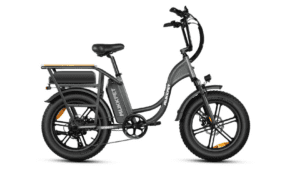
Discover the Mukkpet BREEZE+: Redefining Home Commuting and Cargo Transport
Ready to make your daily commute and family outings a whole lot more exciting?...

AWS Plans to Invest $11 Billion in Indiana to Create 1,000 New Jobs
AWS plans to invest $11 billion in Indiana to create at least 1,000 new...

Alibaba’s Dingtalk Upgrades AI and Launched a Marketplace of 200 AI-Powered Agents
Alibaba’s Dingtalk has upgraded its AI and launched a marketplace of 200 AI-powered agents....

From Traditional to Tech-Savvy: How Corporate Banking is Evolving with Technology
As the world becomes increasingly digital, the corporate banking sector is also experiencing a...

The Future of Money: How Cryptocurrency is Transforming the Financial Industry
Welcome to the future of money, where digital currencies are revolutionizing the financial industry...

Major Technology and Innovation Exhibitions in Germany in 2024 and 2025
Technology and innovation exhibitions play an important role in today’s world. At no time...

From Personalization to Virtual Try-Ons: How Generative AI is Shaping E-commerce
In a world where online shopping has become the new norm, e-commerce businesses are...

Immersive media: The Revolution of Digital Experiences
Discover the impact of the digital revolution in today’s world Immersive media is a...

How Small Business Owners Can Boost Their Online Presence
If 2022 taught us anything about small businesses, it is that nothing is certain....

Essential Tips for Choosing the Right Pool Builder in Central Texas
Choosing the right pool builder is a crucial decision for any homeowner in Central...

Boosting Sales and Customer Engagement: The Impact of Generative AI in E-commerce
In the fast-paced world of e-commerce, staying ahead of the competition is crucial. With...

Mastering the Art of Packaging: Best Practices for Using Ship Boxes in E-commerce
In the e-commerce world, the saying “first impressions count” is more relevant than ever....

AI Face Swapping in Social Media: Trends, Uses, and Impact
The digital landscape is ever-evolving, and one of the most fascinating advancements has been...

Ark Invest Buys $40M Worth Of Its Spot Bitcoin ETF; DTX Presale Records Exciting Whale Activity
TLDR Bitcoin (BTC) dips 0.10% post-Ark Invest’s Bitcoin ETF purchase. Stage 2 of DTX...

How Does AI Contribute to Data-Driven Decision-Making in Startups?
How Does AI Contribute to Data-Driven Decision-Making in Startups? In the fast-paced world of...

Steering Towards Safety: How AI is Revolutionizing Public Transport
Today, we’re diving deep into a topic that’s as fascinating as it is vital...
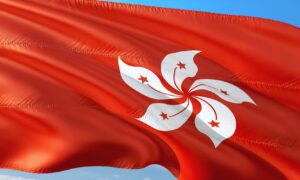
Alibaba Cloud Celebrates its 10th Anniversary in Hong Kong.
Alibaba Cloud has celebrated its 10th anniversary in Hong Kong with different events. Takeaway...
Like Us On Facebook
Latest interview.

Avram Miller Talks About Renovaro And Its Impact In Diagnosing Cancers and Infectious Diseases With AI
The potential impact of AI on healthcare is vast and transformative. With the use of AI platforms for diagnosing diseases like cancer,...
Latest Press Release

NTT DATA and Reiz Tech Announce New Venture to Target DACH
The joint venture – LITIT — built on previous collaborative successes of its parent companies, aims to transform the IT landscape of...
Pin It on Pinterest
Top 5 Advantages Of Travel Management Process Flow
Home » B2B » Top 5 Advantages Of Travel Management Process Flow
Travel managers remain inundated with queries, requests, and suggestions from employees about upcoming business travel plans. Amongst the worst nightmares of a corporate travel manager is handling last-minute changes in itineraries and cancellations. If the manager is dealing with group bookings, the problem multiplies exponentially. To eliminate such issues, corporations require efficient travel management process flow. They can employ corporate travel management companies that have well-defined processes and follow standard steps to handle common and complex problems of business travels.
What is a travel management process?
A systematic way of handling the travel requirements of any corporation is known as the travel management process. The steps have multiple touchpoints and stakeholders such as booking agents, the finance department, the risk management team, and more. Travel management companies use streamlined processes and several corporate travel management platforms to help corporations with numerous travel requests such as new bookings, bulk cancellations, finance audits, and more.
Benefits of travel management process flow
1. itinerary creation and implementation.
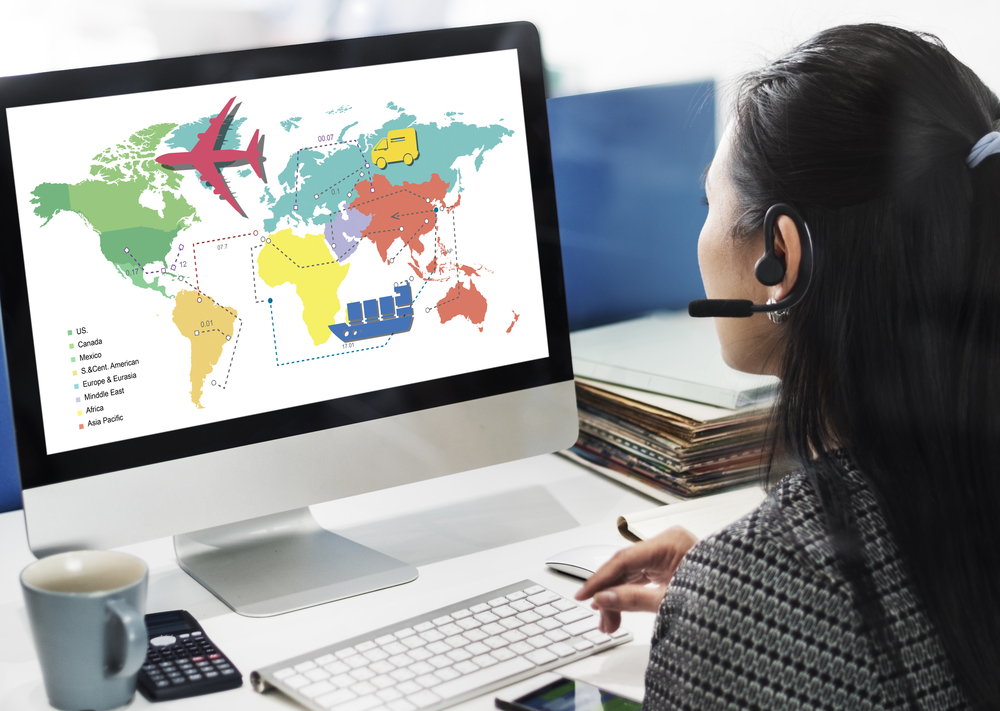
While on a business trip, employees need a defined set of itineraries to know the exact course of action for maximum outcomes. TMCs help in maintaining the booking details of flights, hotels, restaurants, cabs, etc. Further, they use advanced platforms to ensure travel policies are followed by employees on the trip. This helps the employee and corporate keep a track of the schedule of the trip along with the attached expenses. Further, tracking and scrutinizing the itinerary can assist in defining the ROI for future traveling requirements.
2. Use a self-booking platform

Taking good care of your business travelers is the key to success for any business trip. Corporates can opt for a travel management platform such as Paxes with TMCs that allows traveling employees to book flights, hotels, etc. for themselves. This is one significant factor in keeping travelers happy and satisfied along with reducing touchpoints and errors. Employees can plan their travel without bothering the travel manager , sending out emails, or filling out multiple forms. They can choose how they want to travel without moving away from the company’s travel policies. Other benefits of using a self-booking platform are:
- Employees can choose the air travel providers and staying facilities they want
- They can track their frequent flier programs
- They can enjoy all the benefits of an online booking platform
Self-booking allows business travelers to save their own and the administrator’s time. They can exercise their options within the travel budget assigned to them.
3. Streamline approvals process and policies
TMCs backed by AI-powered travel booking platforms simplify the process of business trip booking approvals greatly. The platform shows all the bookings of an organization to the concerned decision-makers and travel managers. After getting approvals with just a few clicks travel agencies can directly confirm the booking details of an employee on business trips. The same along with the itinerary will be updated via notifications to all the involved personnel i.e. the traveling employee, the concerned supervisor, and the travel agency for future reference.
4. Help travelers access direct support
Travel managers may have too many things to deal with, such as calls and emails from business travelers requesting for changes in bookings or itineraries. Most of the times it will be overburdening the managers. Hence, TMCs come to the rescue with direct support to the traveling executives. The dedicated support team of TMCs comes up with innovative solutions within travel policy to cater to the changing requirements of a traveling employee. Further, they can also tackle emergency situations by mitigating risks of travel for the employee in real time.
5. Optimize business travel expenditure instantly
Managing travel expenses in-house can be a tedious and complex job. Administrators and managers with limited knowledge of current costs and policies may be unable to control spending beyond budget policies. Hence, TMCs have committed finance teams. They can provide instant insight into travel costs to keep a track of the travel expenditures of individual employees. Further, reports can be sent to corporate managers for better and detailed analysis of the business travel of an employee.
Business travel can get complicated going ahead as more and more companies look to make the best use of available resources. With business travel making a strong comeback after the COVID-19 pandemic, travel strategies are expected to be different now than what it was earlier. Corporates need best travel management process flow to get maximum ROI on business travels and keep themselves in pace with their competitions.
By researching and choosing the best business travel management companies, you can minimize and even eliminate the downsides and boost the experiences of all concerned. These agencies make use of some of the best travel management platforms like paxes. These platforms empower travel managers with the right tools to make business travel simpler and manage with more flexibility.
Suggested Read: 11 Business Travel Tips For A Comfortable Corporate Travel
Travel Management Process Flow FAQs
Why is the travel management process required.
It helps to cater to the travel requirements of a corporation in an organized manner. It helps resolve bookings, finance, audit, and bulk cancellation queries.
What are the major benefits of having a travel management process flow?
It helps in curating and booking an itinerary. It simplifies the approval process and helps travelers to get direct support.
What are the benefits of choosing a self-booking platform?
Employees are free to select the airlines and accommodations they prefer. They can track and check their frequent flyer program and use all the advantages of an online booking service.
How can TMC help in optimizing business travel expenditures?
Finance teams are dedicated in TMCs. They can give quick insight into travel expenses so that the company can monitor how much each employee spends on travel.
Pratyush is a traveling enthusiast who always looks for innovations in business travel management. He has 5 years of experience writing content on corporate travel management and working closely with expert business travel facilitators.
Leave a Reply
Related posts.

Travel And Expense Policy: Objectives Of Corporate T&E Policy
Among an organization’s most prominent controllable costs, business travel expense is the second largest after salaries. It impacts the organization’s bottom-line irrespective of the company’s size. While ‘travel and expense’ are unavoidable because of their Read more…
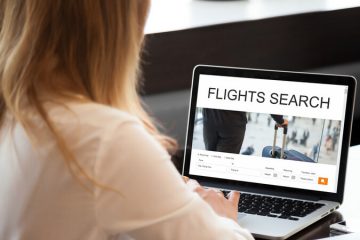
What Is The Meaning Of Open Booking?
Open booking refers to a travel booking approach where employees have the freedom to book their travel arrangements outside of the traditional corporate travel management system. Instead of using a designated platform, employees can book Read more…

Corporate Expense Cards: Types And Benefits
Corporate expense cards for travel ensure easy payment and streamlined management of expenses. These cards can be of any type such as corporate credit cards, prepaid corporate cards, VCC, Airline specific cards, and many more. Read more…
Let's get started!

Thanks for submitting your details.
We'll get back to you shortly.
4 Ways To Improve Your Corporate Travel Booking Process

Corporate travel management can be an entire department unto itself. The endless surge of tasks, from booking flights to arranging accommodations and overseeing the costs, can take up so many of your resources.
Fortunately, you can streamline your corporate travel booking process through automation. There are plenty of digital tools available to help you manage all related information and keep track of your employees’ itineraries.
Here are four ways you can maximise automation for your corporate travel booking process:
Create a Standard Booking Sheet
Make a standard booking sheet that contains the necessary information for corporate travel management. This includes personal data, like the employee’s legal name, contact numbers, address, and passport details.
You can fill in the sheet yourself to ensure the accuracy of your records. Alternatively, you can make your life easier by creating a form that employees can fill in.
Take note that the data should automatically be exported to your booking sheet. Google Forms is an ideal tool for this process because it automatically transfers the data from Forms to the sheets.
A standard booking sheet is crucial for corporate travel management. You can manage a large number of requests and track approvals as well as expenses with ease.
Consider an Automated Corporate Travel Booking Tool
Aside from a standard booking sheet, you can also invest in automated corporate travel booking tools. There are companies that serve as one-stop shops for corporate travel. With just one platform, you can check different airlines, hotels, and trains for the places you need to visit.
Notably, Airbnb has a corporate version of its consumer tool. Airbnb for Work offers the same seamless process for booking accommodation, with a few key differences.
First, bookings are linked to the company profile. This way, your finance team can get a copy of the details and invoice when your employees book a place, eliminating the need to pass information over manually.
Aside from overnight accommodation, you can also book spaces for meetings and conferences. There are temporary offices for rent as well in case you need to do a deep clean or major renovation on your current office.
Your finance team will thank you for investing in a centralised tool that automates the expense report process. Users can easily screenshot receipts for transportation and accommodation, which are automatically matched to your company card’s transactions.
Go Digital With Your Itinerary Files
Additionally, you should reduce paperwork by opting to go digital with your itinerary files. In this day and age, you no longer need to print out flight tickets and hotel bookings. You can just collate them into one document and give them to the travelling employee.
You can find plenty of templates online. The important thing is that you can easily edit and share them with your employees.
Ideally, this should contain everything your staff needs to get to their destination. It should also state the purpose of their travel.
The itinerary must have sections for the flight details, transportation, accommodation, and activities. It should provide information on the employee’s departing and arriving flights, including the dates, times, airport, airline, gate, and confirmation code.
For car rentals, you should include the company name, pick-up and drop-off dates and times, as well as pick-up and drop-off locations. In terms of accommodation, include the hotel name, address, room number, and check-in and check-out dates.
Lastly, make sure to include information on the business activities they should be attending. For instance, if the employee is joining a conference, include the dates, times, places, and activities where they should be present.
If you need to provide more itinerary files, it’s best to create a folder where you can share all the necessary information for business travel. It’s helpful for boosting transparency and accountability in the workplace.
Avoid the Pitfalls and Have Your Employees Book Their Own Travel
To reduce the burden for yourself or your admin team and finance teams , you can have your employees book their own travel. This is ideal if your company constantly sends employees to different places for business.
Just make sure that you set clear business travel policies. Lay down your rules and procedures on how your employees can have their proposed itineraries approved.
It can benefit your employees by giving them flexibility and autonomy over their travel approach, even if it’s for business. On your end, you can promote a positive company culture without compromising your budget and limited resources.
Your business travel policy should have guidelines on lodging, travel and entertainment, and business class bookings. It should also include rules about business frequent flyer miles usage.
For lodging, you can set a maximum hotel star rating or room rate, which employees shouldn’t surpass. It’s also common for companies to limit rooms to standard types and restrict bookings for deluxe suites or higher.
Be clear on what you will and will not reimburse, whether it’s room and dry-cleaning services or the use of hotel amenities. Take note of seasonal fluctuations in accommodation prices as well.
State your rules for spending limits on meal expenses, especially when they’re using the company card to entertain clients. Provide clear instructions on where they should send original receipts and other documents to process reimbursements.
Right at the start, you should be clear on whether employees can or cannot book business class flights and if there are exceptions. Business-class bookings may be cheaper once you’ve considered baggage fees and in-flight meals in the calculation.
Lastly, you should include a section about business frequent flyer miles for personal use. Some businesses offer it as an additional perk for the employee and allow them to use it for personal travel. Others, though, clearly stipulate that the miles should be used to save money on future business flights.
Improve your company’s booking process in a few easy steps. Maximise standard booking sheets, digital itinerary files, and dedicated business travel apps to streamline the process.
Through corporate travel management tools, employees can also book on their own as long as you set clear policies and procedures.
Sign up to get all of the latest updates and news.
Identify the Risk: How to Approach a Travel Risk Assessment

5 Travel Tips to Reduce Your Carbon Footprint

More relative insights and news.

5 Major Trends Affecting the Corporate Travel Industry

5 Tips to Help Reduce Your Travel Spend

6 Tips on How To Master Corporate Travel Management
Travel Agency Booking Process
Streamlining the travel booking process for a more satisfying and efficient customer experience.
What is this about?
This template is designed to automate and simplify the travel booking process. It ensures seamless collection of customer travel preferences, verification of availability, booking confirmation, and regular communication for a better customer experience.
Automated Booking Process
Utilize our visual builder to design your entire booking process, reducing manual tasks and speeding up operations.

Travel Preferences and Verification
Collect customers' travel preferences and verify availability in real-time.
Seamless Communication
Maintain continuous communication with the customer throughout the booking process, from initial inquiry to final confirmation.

Booking Tracking
Enable customers to track their booking status, enhancing transparency and customer satisfaction.
The process of travel agency booking can often be complex and time-consuming. Our Travel Agency Booking Process template simplifies this process, ensuring a smooth customer experience and efficient business operations.
Customer-facing workflow:
Travel inquiry.
Customers can log in to the portal and submit their travel preferences, providing necessary details.
Availability Verification
The travel agency verifies the availability of the requested travel services and shares the options with the customer.
Booking Confirmation
Once the customer selects their preferred option, the booking is confirmed.
Payment and Invoice
The customer makes the payment and an invoice is generated and sent to the customer.
Customers can track the status of their booking from confirmation to the date of travel.
Reimagine the way you work with clients
Streamline repetitive processes.
Build and automate client workflows to avoid forgotten tasks and reduce manual work
Create Flexible Portals
Simplify data & files collection from your clients on each step of your business processes
Keep Clients up to Date
Let clients track their progress on every step of the process via private portals
Secure Payments
Simplify your payment collection by creating payment forms on your client portal
Save time by using pre-built templates for your processes. Or create your own!
Mobile-Friendly
Let everyone use your client portal on the go
Try Beau for free

We use cookies to provide and improve our services.
By using our website you consent to cookies. Learn more
- Deutschland
- Asia, Australia & New Zealand
- Europe, Middle East & Africa
- United States & Canada
- Latinoamérica
of leisure travelers always book with the first air brand that comes to mind when they start their research.
Google/Ipsos MediaCT, "The 2015 Travelers Road to Decision," Aug. 2015.
Share this page
Travel trends 10, related data.
More than 160 million people have gone into their Google Accounts to review and adjust their privacy settings.
Responsible marketer 02
of experience bookings are happening once travelers arrive at their destination.
Travel search 01
Search interest in the U.S. for “my activity,” where people can manage information saved to their Google Account has increased sixfold since 2016.
Responsible marketer 01
Travelers who book their activities ahead of their trip spend 47% more on lodging and 81% more on transportation than those who wait to book in destination.
Travel search 02
In the 12 weeks leading up to a trip, there are 3X more experiences searches than hotel searches.
Travel search 03
In the 12 weeks leading up to a trip, 8X more experiences searches than air searches
Travel search 04
Manage Reservations
Special car rentals, car rentals, find your car, rewards center, miscellaneous, select topic, manage rental, post rental, rewards program.
Common Questions on Return
Return Process
What do i need to do when returning.
To return your vehicle at locations with Dollar e-returns, pull up to the designated drop-off location, drop off your car (leaving the keys in the cupholder), and go. You will receive your receipt via email to the email address listed on your rental agreement or you can find it later here .
Can the additional driver return the vehicle?
Yes, as long as the additional driver has been added to the rental, they may return the car for you.
What do I do if I am returning the car after the locaiton has closed?
This varies by location. Please contact the Dollar location directly by finding their number here
How else can we help?

IMAGES
COMMENTS
When making changes to your business travel management process, start by listing out all of these factors in detail. 2. Use a booking platform that allows travelers to book for themselves. Taking care of your business travelers is key to a successful travel management program. If your team isn't happy, then the process isn't working.
With online scheduling platforms, your company is accessible every day of the week, 24 hours a day. To reserve a golf time, go anywhere. In other words, your clients can book a table whenever it works for them. Consumers spent more than $450 billion online in 2017, and this figure is only going to rise.
Airline booking process steps. With some basics covered, let's closely look at what happens between the moment of reservation via a travel platform and baggage reclaim at the destination airport. The whole process of this traveler/airline interaction can be divided into several major steps: flight search, flight booking, ancillary booking,
How To Improve Your Travel Booking Process . As a tour operator, one of your main goals should be to make the travel booking process as smooth and simple as possible, ensuring that customers looking to book a travel experience land on your booking page and follow through to the end of the process, resulting in a conversion.
The whole process of this traveler/airline interaction can be divided into five steps: seat booking, ancillary booking, payment, ticket confirmation, check-in and boarding, and baggage reclaim. Flight booking. Today, when a traveler or a travel agent books a flight, they have a choice: Use either an indirect or direct booking channel.
The more up-front communication the better. By taking a few minutes to document travel booking "best practices," you'll: Save time by cutting down on back-and-forth. Establish what factors are most important for the traveler's comfort and convenience. Encourage use of cost-effective options that fit within the traveler's parameters.
The perfect booking process may not exist, though some sites are clearly incorporating more of these features than others. Travel booking can be a lengthy process and, out of necessity, users are required to enter a lot of information at times. However, a focus on creating the best possible user experience can do a lot to reduce abandonment rates.
With WeTravel, tour operators have several options to create a self-service travel booking process for your clients. Everything is customizable and you can: Create a booking page with an embedded checkout and generate a direct link. Embed a Book Now button on your website. Embed your trip on your website.
The primary purpose of an online booking system is to make it possible for guests to self-book and pay on your website — all of the back-end management features are just a huge bonus! So, you're probably wondering what the online booking process looks like from the guest's perspective. Because if they can easily follow the steps on their ...
An online process enables your customers to book at 2am, 9pm or at the last minute if they choose, capturing their interest whenever it suits them. As such, live availability and booking is a must: whether customers are on your website, a review site such as TripAdvisor or online travel agencies such as Booking.com or Expedia.
Leveraging Google Forms will help export the data to the sheet without hassles. 5. Automate corporate travel booking. Using established tools to automate the corporate travel booking process will reduce the stress of finding the right hotels, flights, and trains to cover the destination of the business trip.
2. Include a browse page for specific tours. It's likely you have more than one tour and activity for a guest to choose. While it seems like a good idea to list everything on the homepage, it can be overwhelming for visitors — especially if they're just browsing. Instead, you should break your items into categories.
Best online travel booking systems for B2C. 1. Skyscanner. Skyscanner is a travel search engine and aggregator that uses a metasearch engine to compare flight prices from various travel providers. Users select their flight options and click through to the provider's website to complete the booking.
Implementing a SaaS (Software as a Service) solution for the travel booking process can significantly simplify and enhance the entire process for businesses. Here are ten ways in which SaaS solutions make the booking process easier. Streamlined Booking Process. SaaS solutions provide user-friendly interfaces that simplify the booking process.
Travel Booking Process for Domestic and International Travel. Review the Global Safety & Security Travel Policy to determine if your trip meets the guidelines for permissible travel and follow any applicable review and approval requirements.; Secure any approval to take the trip required in the travel policy, and work with the appropriate manager to ensure that funds are available.
By having control over travel spending, the travel booking process and implementation of your corporate travel policy, you can avoid a lot of problems in the future. By understanding the benefits of creating a travel management program, as well as the problems that can arise when implementing it in your company, you can find the right path to ...
Consider the modern-day travel booking process. You'll notice that it involves several different touchpoints. Your guest might start their travel planning with a simple Google search: "best places to go skydiving." From there, they might land on your company's blog post titled, "Top 10 Best Skydiving Locations in the U.S."
The process for booking ground transportation is similar. You'll need to enter your origin and destination information, as well as the desired travel dates. Depending on the mode of transport, there may be additional options to select, such as class (e.g., economy, business, first class) or cabin type (e.g., single-occupancy, double-occupancy ...
Benefits of travel management process flow. 1. Itinerary creation and implementation. While on a business trip, employees need a defined set of itineraries to know the exact course of action for maximum outcomes. TMCs help in maintaining the booking details of flights, hotels, restaurants, cabs, etc. Further, they use advanced platforms to ...
Create a Standard Booking Sheet. Make a standard booking sheet that contains the necessary information for corporate travel management. This includes personal data, like the employee's legal name, contact numbers, address, and passport details. You can fill in the sheet yourself to ensure the accuracy of your records.
Streamlining the travel booking process for a more satisfying and efficient customer experience. What is this about? This template is designed to automate and simplify the travel booking process. It ensures seamless collection of customer travel preferences, verification of availability, booking confirmation, and regular communication for a ...
Describe how a booking process works with this segmented travel booking process flow diagram. There are three key segments shown in this diagram based on their role. Each segment is assigned tasks in their respective columns and the arrows connect the players, their roles and tasks into a cohesive process. This template is a great way to show ...
Now travelers can rely on technology to streamline their booking process, and travel managers get greater insight into employees' mobility needs and spending throughout their trip.
Appears In. Travel trends: 4 mobile moments changing the consumer journey. 3 X. 8 X. 14% of leisure travelers always book with the first air brand that comes to mind when they start their research. Discover more travel booking data on Think with Google.
Main Association Discounts Travel Partners Travel Agents Travel Tools. Miscellaneous. Mobile Apps Lost & Found Blackout Dates. Login. Join. Home / Support Center / Return / Return Process. Select topic. Booking. Manage Rental. On Rent. Return. Post Rental. Rewards Program. Common Questions on Return.